A Summary of This Very Extensive Section
Attempts at a post-Napoleonic comeback of Europe's feudal monarchies
Post-Napoleonic monarchies worked hard to put themselves
back in charge of events (1815
Quadruple Alliance) ...
resulting in the "Concert of Europe" designed to keep things
diplomatically under reasonable control among themselves ... and a
cooperative spirit to
restore social order at home
But social reform inspired by Napoleonic France led Louis
XVIII (1814-1824) was kept in
place with a bi-cameral
legislature and freedoms of press and religion.
Metternich dominates the Austrian Empire (1815-1848) in an
effort to preserve imperial
power in a very mixed
ethnic-nationalist empire
Britain becomes rather reactionary under George IV (1820-1830)
... but largely unloved in
Britain
A New Netherlands is formed uniting the Northern Dutch provinces
with the Flemish
provinces under William I (1815-1840)
– to produce something of a buffer state amidst
Britain, France and Germany
Although William
would lose the Flemish provinces with a rebellion of 1830 ... formalized in
1839
Prussia under Friedrich Wilhelm III (1797-1840) plays a much
bigger role in the German world
... although the 39
German states of the Germanic Bund continue under Metternich's
Austrian leadership
Russia continues under Alexander I (1801-1825) – a strange
mix of mystic, reformer, and –
in his later years – reactionary; he creates a "Holy
Alliance" but only Prussia and Austria
join him
The Ottoman Turks under Mahmud II (1808-1839) find
themselves caught up in harem
politics and corruption of the
Janissary military corps ... the latter finally disbanded by
Mahmud; he institutes the Tanzimat or reorganization of his
government – to modernize
his rule. But
this merely gives more power to his regional governors or pashas
...
especially Egyptian Pasha Muhammad Ali, who works hard to modernize his Egyptian
military
and bureaucracy ... and cotton industry – thus establishing his own dynastic rule
in Egypt
(lasting until 1952)
European ethnic groups under Turkish rule attempt national
independency, the Wallachians
(Romanians) failing, but the Greeks succeeding – the
butchery involved in the Turkish
putdown of the Greeks that other Europeans
become involved in (1827); in 1832 the
Turks recognize Greek independence – under Otto of Bavaria; and
in 1830 the Turks were
forced to recognize Serbian independence – in process (with early
Russian help) since the
Napoleonic Wars
Meanwhile, Germans were trying to bring their many
independent states together into a
single political union or Bund;
but Metternich was able to hold off student demands for
such a union with the
many German princes
signing the Carlsbad Decrees (1819) – very
reactionary to the militant students
Upheaval in Latin America
Meanwhile, France had lost possession of Haiti during
Napoleon's early years (1803 – in
military defeat ... and with sickness
and other more important matters undercutting
French commitment to Haiti)
Spain was quickly losing its colonies in America – revolt
breaking out in "New Spain" in 1810
– with a
Declaration of Independence in 1813 ... although political unity would not come
to "Mexico" until 1821 under
a new monarchy, then a republic in 1824 ... while the idea of
a monarchy
remained strong in Mexico
In 1810 Bolivar leads a rebellion in "Gran
Colombia") against Spanish rule ... escaping to Haiti
– then returning in 1821 to
Venezuela to set up his new republic as its president
Brazil becomes independent only by the move of Portuguese Prince John
VI in 1807 to Brazil
to conduct Portuguese politics from there; Portuguese
politics finally leads in 1822 to
Brazilian independence under Prince Pedro (who dies in 1831)
Spanish lands in Central America declare independence as a
federation in 1823 ... but break
into separate states in
1838 – formally ending the federation in 1841
Such Hispanic independence was well supported by both
Britain (for commercial reasons)
and America (for diplomatic reasons) under the 1823
"Monroe Doctrine"
The Revolutions of 1830
The wisely cautious rule of Louis in France ends when his
reactionary brother Charles takes
control in 1824.
Charles's "July Ordinances"
of 1830 cutting back parliamentary representation sparks the
"July Revolution" in France
Talleyrand and Thiers force
Charles to abdicate ... bringing Louis Philippe of Orleans to
the throne
Louis Philippe poses as the
"people's king;" but French prosperity actually forms his rule
Dutch King William I demands
Dutch to be the royal language (exempting Wallonia) of his
realm – infuriating the French-speaking middle and upper classes of
Flanders
Inspired by French July events,
rebellion breaks out in Brussels in August (1830)
Dutch, Prussia and Russia military come
to William's aid, but France supports the Belgian
decision to secede
And a London Conference recognizes Leopold of Saxe-Coburg as
Belgium's new king
Although Poland had been
"disappeared" in the latter 1700s, Napoleon establishes a Warsaw
Duchy
But the Congress of Vienna
simply places the Duchy (now as a kingdom) under Tsar
Alexander
Tsar Alexander and then (after
1825) his brother Nicholas try to respect Polish integrity
... both however becoming more reactionary with time
Finally the spirit of 1830 hits
the Poles ... but they are not able to fend off the Russian
army and Poland is simply absorbed into Russia ... although Polish
nationalism will
only strengthen over time
Unloved British king George IV
dies and his more liberal brother William IV takes the throne,
reforming Parliament (1832) by getting rid of the "rotten
boroughs" and awarding seats to
citiesas well as increasing the suffrage to include middle class
voters (still only a minority)
And America goes through its
own "democratizing" with Jackson becoming president ... not
changing political realities (America was already fully democratic) but
heightening the
democratic "image"
And a "Second Great
Awakening" stirs new social-political fervor across America
Texas independence (1836) and
its joining the Union (1846) lead Mexico to declare war
on America – a war which the Mexicans lose most horribly... and which stretches
America to the Pacific
The Revolutions of 1848
The rapidly increasing French
industrial working class is furious about its lack of political
rights – and with the help of "Socialist" intellectuals –
begin demanding such rights ...
making King Louis Philippe and his Prime Minister Guizot reactive
A massive banquet in Paris in February
of 1848 brings reformers and military into conflict
But the soldiers refuse to fire on the crowd ... and Louis
Philippe fleas France
The French then declare a new
Republic headed by a provisional government
But the new government gets caught financially in a welfare program it can not
manage
(thousands flock to Paris) – 10,000 becoming killed or wounded under martial law
But a new constitution with
universal male suffrage leads to the election (Dec) of Louis
Napoleon as President
A similar explosion erupts at
Rome, demanding a new Roman Republic to replace the Papal
States
But Louis Napoleon sends an army to support Pope Pius IX (1849) ...
bringing the pope
back – and maintaining a protective presence there ... until conflict
breaks out again
in 1870
In Vienna in March, students
and workers march in protest against Metternich - who fleas to
England
Demands for reform then spread to Prague, Budapest
But the anti-Habsburg revolt
also spreads to Milan, Venice and other Italian city-states in
the north of Italy
The Italian city-states agree
to unite under Charles-Albert, king of Sardinia-Piedmont
But Austrian troops defeat Charles-Albert's army ... who
abdicates to his son
Victor-Emmanuel
Victor-Emmanuel however refuses to submit to Austrian authority
... and supports liberal
democracy
Meanwhile, the Habsburg empire
seemed to be crumbling everywhere
Emperor Ferdinand then (1849) simply abdicates to his
18-year-old son, Franz Joseph
And in Prussia, King Wilhelm IV
submits to the demand for liberal reforms
In Frankfurt, delegates to a
constitutional assembly gathered to put a German
Confederation in place
But by 1849 Germany reformers find themselves divided as to whether the Austrian or
Prussian monarchy should head their confederation
The assembly finally decides in favor of Prussia's William IV ... who, however, has
no
interest in such popular government
As the reform effort crumbles, William
sends troops to put down rebellions spreading
across the German states
And the Austrians are able to
retake much of what they so recently lost in Hungary and
Italy
From
the defeat of Napoleon in 1815 to the outbreak of World War One almost
exactly a century later (1914) Europe experienced its first long period
of relative peace in 300 years – since the onset of the Protestant
Reformation in the early 1500s marking the beginning of the break-up of
old Christendom. "Relative peace" is the correct term because
there would be European wars during the 1800s. But they would be
brief and limited in scope compared to the previous European dynastic
wars.
To a great extent this was so because the Europeans focused their
energies more on overseas opportunities for their own imperial
expansion. Also the Napoleonic wars had put such a scare in the
hearts of the European monarchs and aristocrats that they realized the
absolute importance of not letting their rivalries get out of
control. Thus was birthed the "Concert of Europe" – regular
gatherings of European heads of state to work out their differences – a
diplomatic system that guided European continental politics fairly well
during the rest of the 1800s.
It was the foolish disregarding of
this system in the early 20th century that would finally push Europe
into two tragic rounds of a devastating rivalry (World Wars One and
Two) ... which would result ultimately in Europe's fall from its
position as the political center of the world.
THE RESTORATION OF THE MONARCHIES |
|
The Congress of Vienna (1814-1815)
The
Congress of Vienna first assembled with Napoleon's initial defeat in
1814 ... for the purpose of putting Europe back together again in a
form as close as possible to the way it looked before the French
Revolution. Kings, emperors, and diplomatic delegates came from
all over Europe (even Turkey) to participate in this grand event.
The major concerns were what to do with a post-Napoleon France ... and
how to reorganize and distribute among the victorious European powers –
in particular Great Britain, Prussia, Austria and Russia – the various
lands (most notably the Netherlands, Italy, Poland, western Germany,
Norway and Finland) previously shaped by Napoleon's dominating
influence. A balance of power among those four major powers was
their goal. This balance was the best guarantee that their own
squabbles would not get out of hand again. They had no intention
of allowing the lower social orders or classes to get involved ever
again in any future political conflicts arising among Europe's
royalty. Thus they signed a Quadruple Alliance (1815) promising
to meet regularly (the Concert of Europe) over a period of at least
twenty years to consult on any matter affecting their relationship.1
1France would join the alliance in 1818.
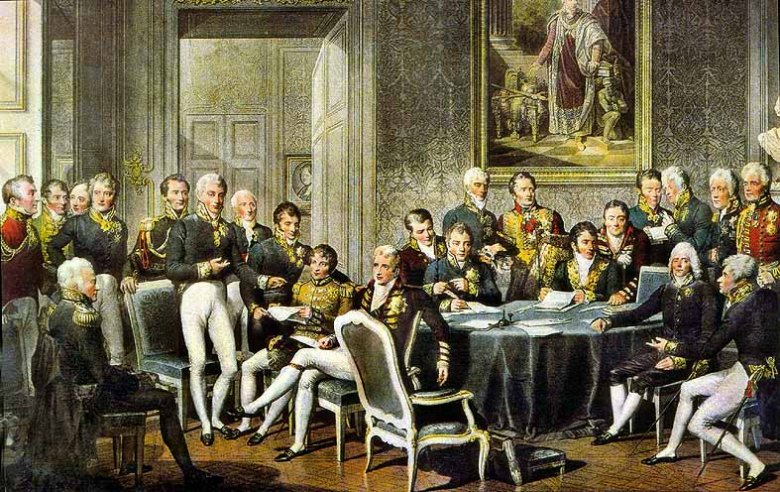
The Congress of Vienna - by Jean-Baptiste Isabey
|
France
But treaties among Europe's kings and emperors would not take care of
issues brewing within each of the countries. France in particular
would have a very difficult time with lingering domestic social forces
unleashed by the Revolution.
The Bourbon dynasty was restored to
the French throne, with Louis XVIII, brother of Louis XVI, now King of
France.2 The 60-year old, gout-inflicted Louis XVIII had come to the throne after watching the butchering of the
French royalty and much of the French aristocracy during the Revolution
– and watching the success of Napoleon at the head of a popular ("the
peoples") French army. He was wise enough to draw some important
conclusions for his own tenure in office: the days of royal rule,
conducted without concern for the people, were over. Consequently, Louis issued a
very Liberal Charter of 1814, guaranteeing a bi-cameral legislature to
govern with him ... and freedom of the press and religion. He
retained most of the governmental reforms put in place by
Napoleon. He also promised the rising middle class or bourgeoisie
that he would abolish a number of key taxes. (But he would not,
could not, keep such a promise. His treasury was empty). Thus it was, nonetheless, that his reign proved to be a time of greatly appreciated peace.
2Ten year-old Louis XVII, son of Louis XVI, died in a Republican prison in 1795.

French King Louis XVIII (reigned 1814-1824)
|
Austria
Not only was the post-Napoleonic gathering held in the Austrian
capital, Vienna, but much of its work in redrawing the post-Napoleonic
map of Europe was engineered by the Austrian Foreign Minister,
Metternich. It might even be said that the European diplomatic
era following the defeat of Napoleon was something of the "Age of
Metternich" (1815-1848).
Napoleon's politics had finished off the ancient position and title of
Holy Roman Emperor. But Austria's ruler, Francis, took for himself
the title of Francis I, Emperor of Austria. Austria was however just about
as complex a political entity as the Holy Roman Empire had been.
The Austrian Empire was German at its core, but spread widely so as to
incorporate many other ethnic or national groupings, including
Hungarians, Poles, Italians and Czechs. With the
Napoleon-inspired rise among the various ethnic groups of Europe of a
distinctly popular or "nationalist" spirit, directing Austrian politics
on a stable course was going to be extremely difficult for Austria's
Habsburg Emperor and his Foreign Minister (and, after 1821,
Chancellor) Metternich.
|
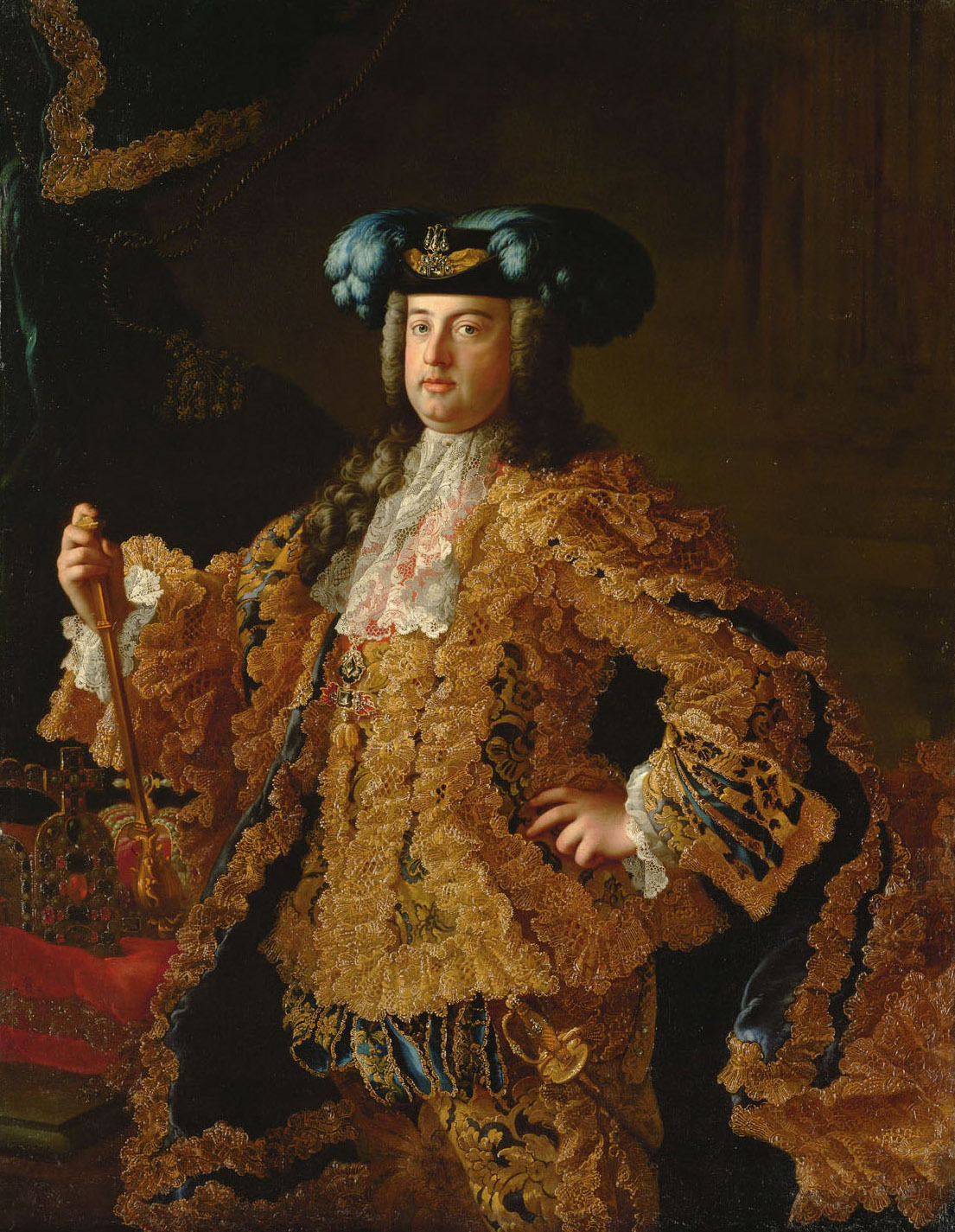
Francis I – Emperor of Austria (1804-1835)
(formerly Francis II - Holy Roman Emperor – 1792-1806)
by Joseph Kreutzinger (c. 1815)
Universalmuseum Joanneum - Graz, Austria
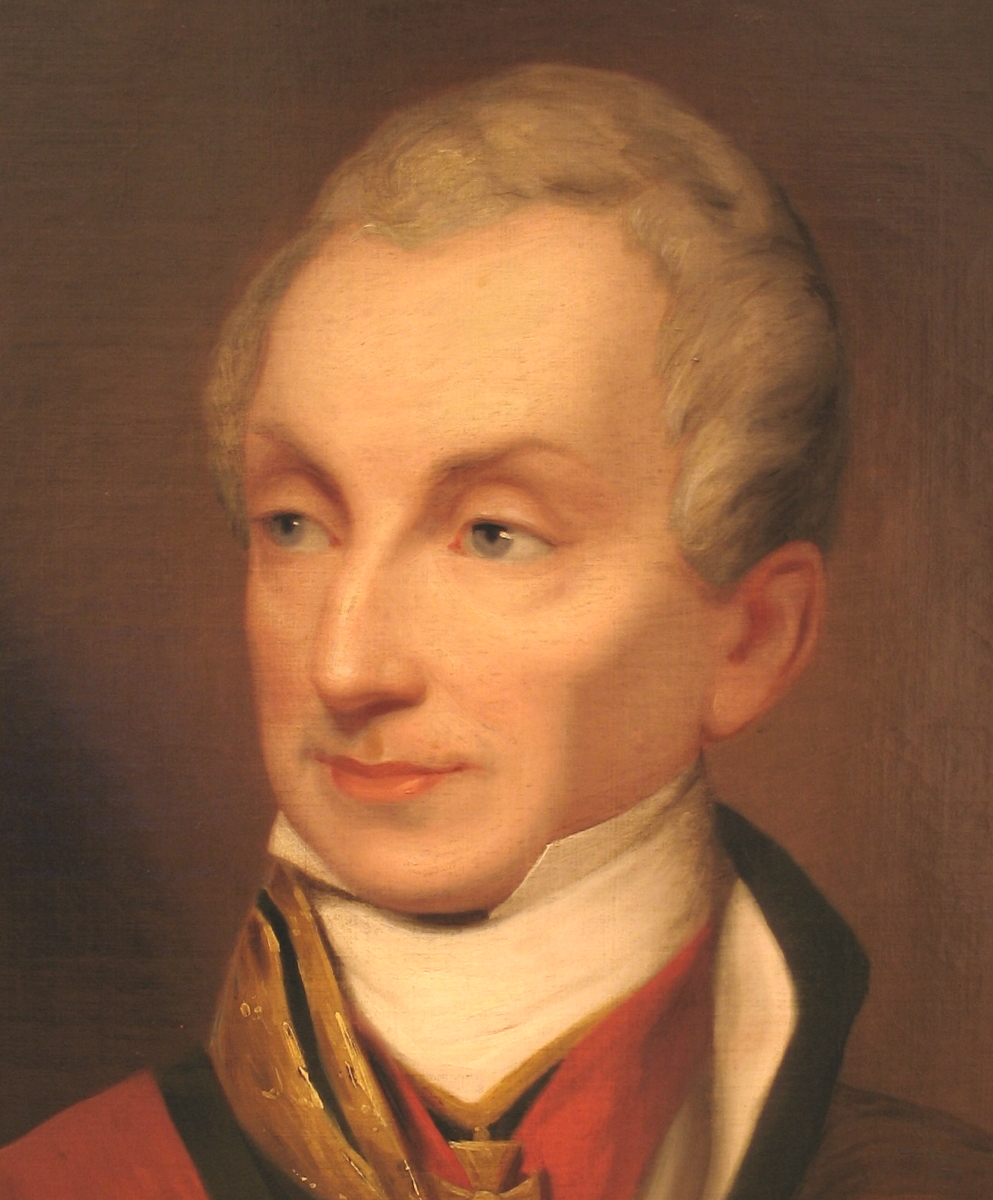
Prince Klemens von Metternich
Foreign Minister and Chancellor of the Austrian Empire (1809-1848)
|
Great Britain
Since 1810, when the British King George III had fallen rather
permanently into a state of insanity, Britain had been led by George's
son George as Prince Regent, and by a number of capable cabinet
ministers, including notably Jenkinson (Lord Liverpool), Castlereagh,
Wellington, Canning. When George finally died in 1820 his son
took the throne as George IV ... and British politics took a decidedly
more reactionary turn (1820-1830). The main issues impacting his
short reign were the Catholic Question – George IV being strongly
opposed to any loosening of the restrictions against Catholics in
office – and his scandalous efforts to divorce his wife. On both
matters he failed to get his way, diminishing his stature considerably.
Towards the end of his reign he became reclusive, being massively
overweight and nearly totally blind. When he died in 1830, there
was no sadness or regret among his people.
|
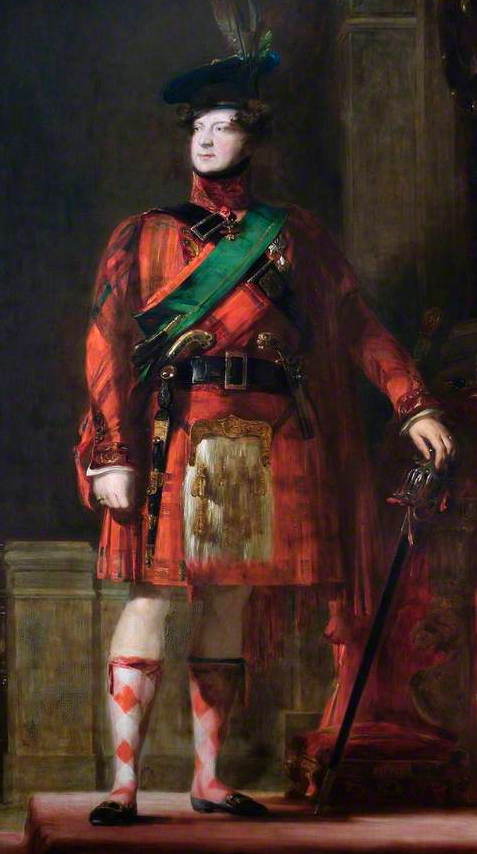
King George IV (regent 1810-1820; king 1820-1830)
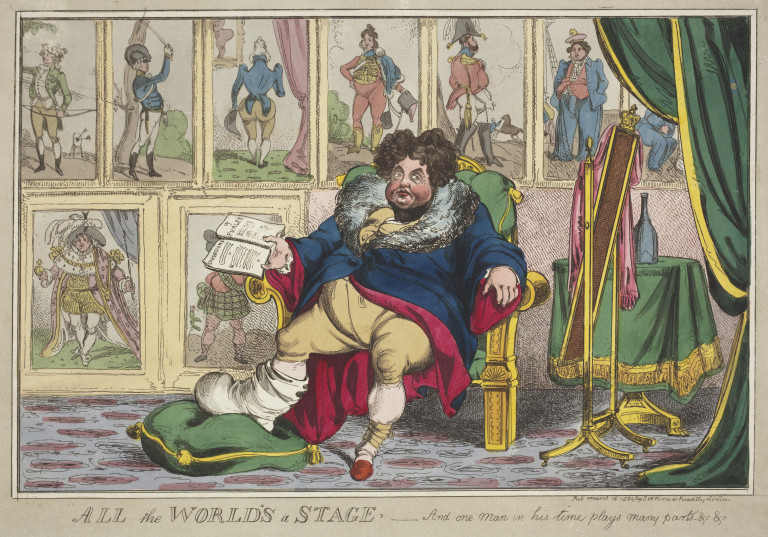
Unflattering cartoon of gouty George IV ... with pictures of himself behind him
|
The Netherlands
Napoleon had replaced the Batavian Republic, established during the
French Revolution, with the Kingdom of Holland – placing his brother
Louis Bonaparte as its king. With Napoleon's downfall, William
Frederick of Orange, son of the last stadtholder, declared himself King
of the Netherlands. Then during the Congress of Vienna, the
Catholic southern provinces – that had been exchanged back and forth
among Spain, France and Austria – were combined with the northern
provinces to create a new United Netherlands ... William Frederick as
its King William I.
The logic behind the major powers creating this stronger entity was to
put some kind of barrier state or neutral territory separating Great
Britain, France and Germany from each other.
|
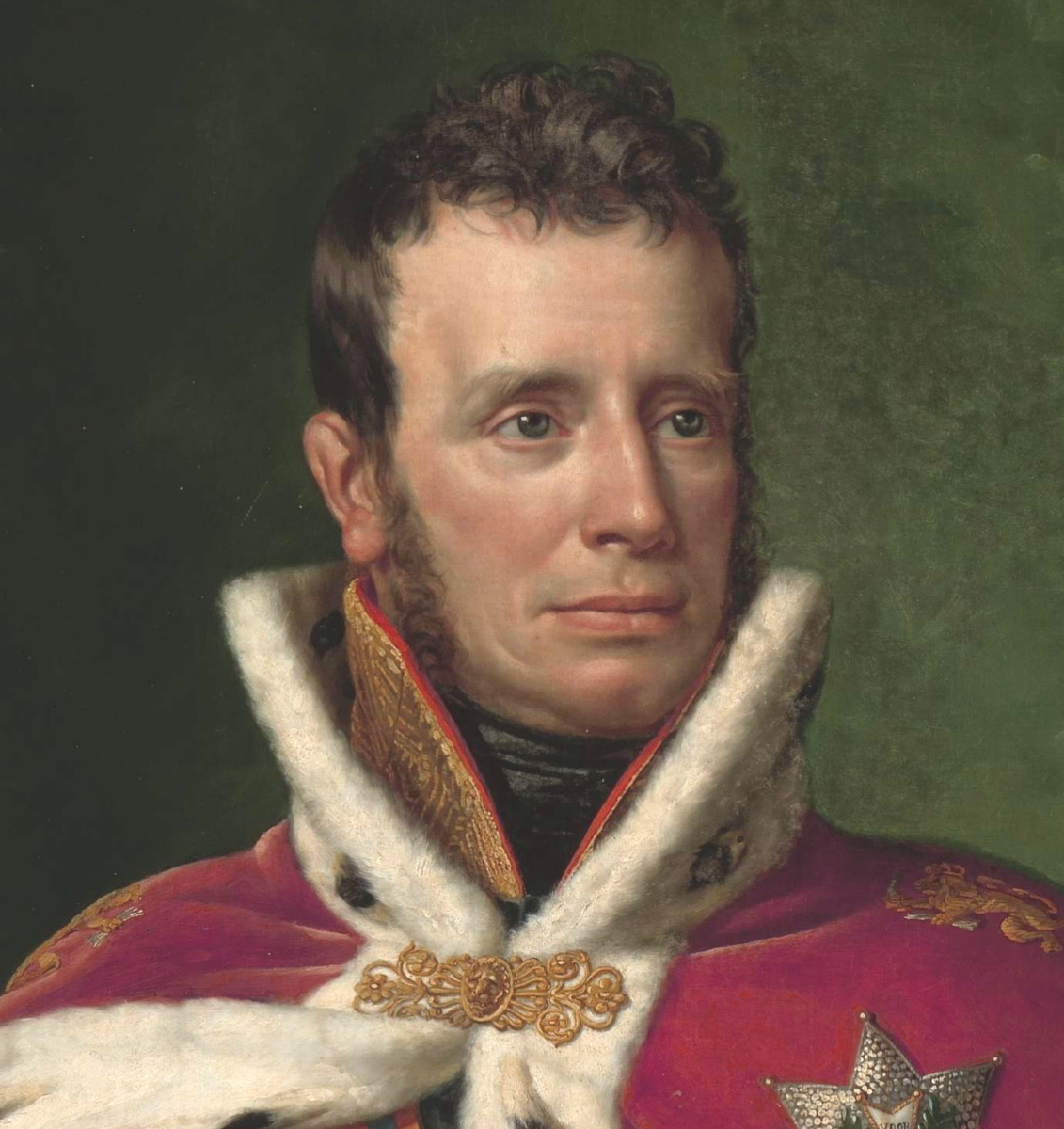
King William I of the Netherlands (ruled 1815-1840)
|
Prussia
Prussia continued after the war to be ruled (1797-1840) by Friedrich
Wilhelm III. He was not a particularly outstanding king, relying
on his ministers to bring Prussia her diplomatic and military
successes.3 His one burning desire personally seemed to be to
impose a rigid Protestant regime over his lands, forcing the unity of
the Lutherans and Calvinists as a single Prussian Protestant Church
(1817) ... over which he personally presided.
The Deutscher Bund (Germanic Confederation)
The 39 German states of the old Holy Roman Empire (including Prussia)
were loosely united (1815) as a Germanic Bund or union. The Bund
had its own legislature (the Diet) ... but was under the presidency of
Austria ... and thus, to the extent it had any real power at all (which
indeed was slight), was shaped by the conservative or reactionary
policies of Metternich.
3The
one diplomatic success most urgently sought by the Prussians in Vienna
was the acquisition of Saxony. But Austria and Great Britain,
seeing danger in such a growth of Prussia, blocked this move.
Ultimately the Prussians had to give up the quest.
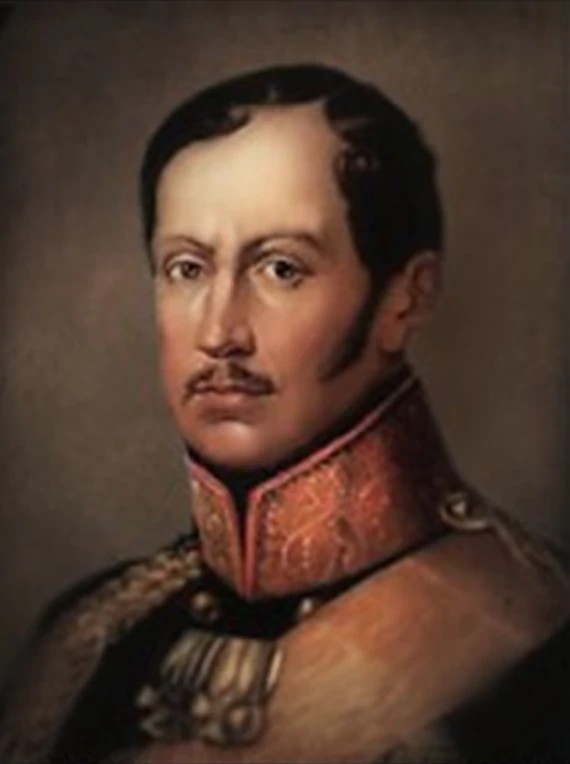
Friedrich Wilhelm III of Prussia (ruled 1797-1840)
|
Russia
Russia continued under the rule (1801-1825) of Alexander I ... a
strange personal mix of mystic, plus sometimes liberal (the earlier
part of his reign), sometimes reactionary (the latter part of his
reign), in personality.
When he came to the Russian throne in 1801, he announced himself
as a liberal reformer ... though he was slow to act on these reforms,
and did not get far before he proved himself to be a rather traditional
autocrat. In fact by the end of his reign he had become quite a
reactionary. It was rumored that he had come under Metternich’s
powerful influence, although Napoleon’s earlier betrayal as an ally
with his attack on Russia, plus popular uprisings Alexander did not
understand or sympathize with (such as the Greek anti-Ottoman revolt)
and growing discontent among young Russian officers, unhappy over the
backwardness of Russia, played their own part in Alexander’s retreat
from liberalism.
He was the one who dreamed up the idea of
a "Holy Alliance" to which he invited all the participants at the
Congress of Vienna to join ... largely as a defensive alliance against
the kind of political culture unleashed by the French Revolution and
Napoleon. Ultimately only Austria and Prussia humored him by
joining his Alliance. France and England had no interest in
getting entangled in Alexander's religious crusade – though they did
participate in the Quadruple / Quintuple Alliances, with something of a
parallel political agenda.
|
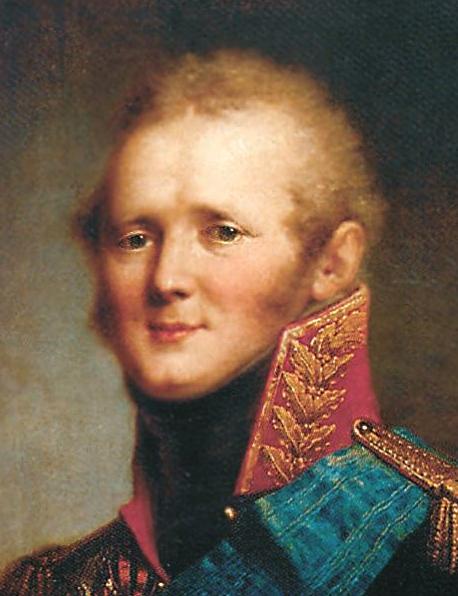
Alexander I Emperor (Tsar) of Russia (ruled 1801-1825)
|
The Ottoman Turks
From the high point of their assault (but ultimate defeat) at Vienna in
1683, the Turkish Ottoman Empire had been on a steady path of decline –
militarily, politically, socially and morally. The quality of the
Ottoman sultans had deteriorated steadily, personal weakness and even
insanity increasingly affecting the character of the sultanate.
The Imperial Harem of Valide Sultans (mothers of the sultans) gained
dominance over the process of selecting sultans (usually minors when
sultans first took their thrones) and then the Haseki Sultans or wives
of the sultans took over the positions of dominance after that.
Consequently the objective of Ottoman rule ceased to be the welfare of
the Ottoman Empire, but instead became the advancement of the fortunes
of one or another of the harem families (run by women slaves) in
competition with each other.
Also the Janissary military corps had become highly privileged,
wealthy, corrupt ... and largely useless as a military
institution. Sultans had been made and unmade (murdered usually)
by various Janissary groups ... weakening even further the Ottoman
Empire.4
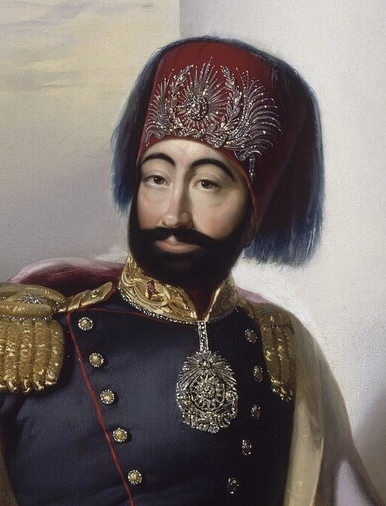 Sensing the need for deep reform, in 1826 Sultan Mahmud II (ruled 1808-1839) made the
decision to disband the Janissaries ... facing a bloody revolt from the
Janissaries in the effort. But he did succeed ... and began the
process of rebuilding Ottoman power based on a more modern army (but a
very slow process at this point).
Sensing the need for deep reform, in 1826 Sultan Mahmud II (ruled 1808-1839) made the
decision to disband the Janissaries ... facing a bloody revolt from the
Janissaries in the effort. But he did succeed ... and began the
process of rebuilding Ottoman power based on a more modern army (but a
very slow process at this point).
Then there was the matter of the pashas, Ottoman noblemen who were
given increasing responsibility in the governance of the provinces and
the Ottoman military. As the sultan's effective governance over the
empire weakened, his responsibilities were gradually taken up by a
number of the pashas, thus constituting themselves and the regions of
their governance as increasingly semi-autonomous realms within the
empire.
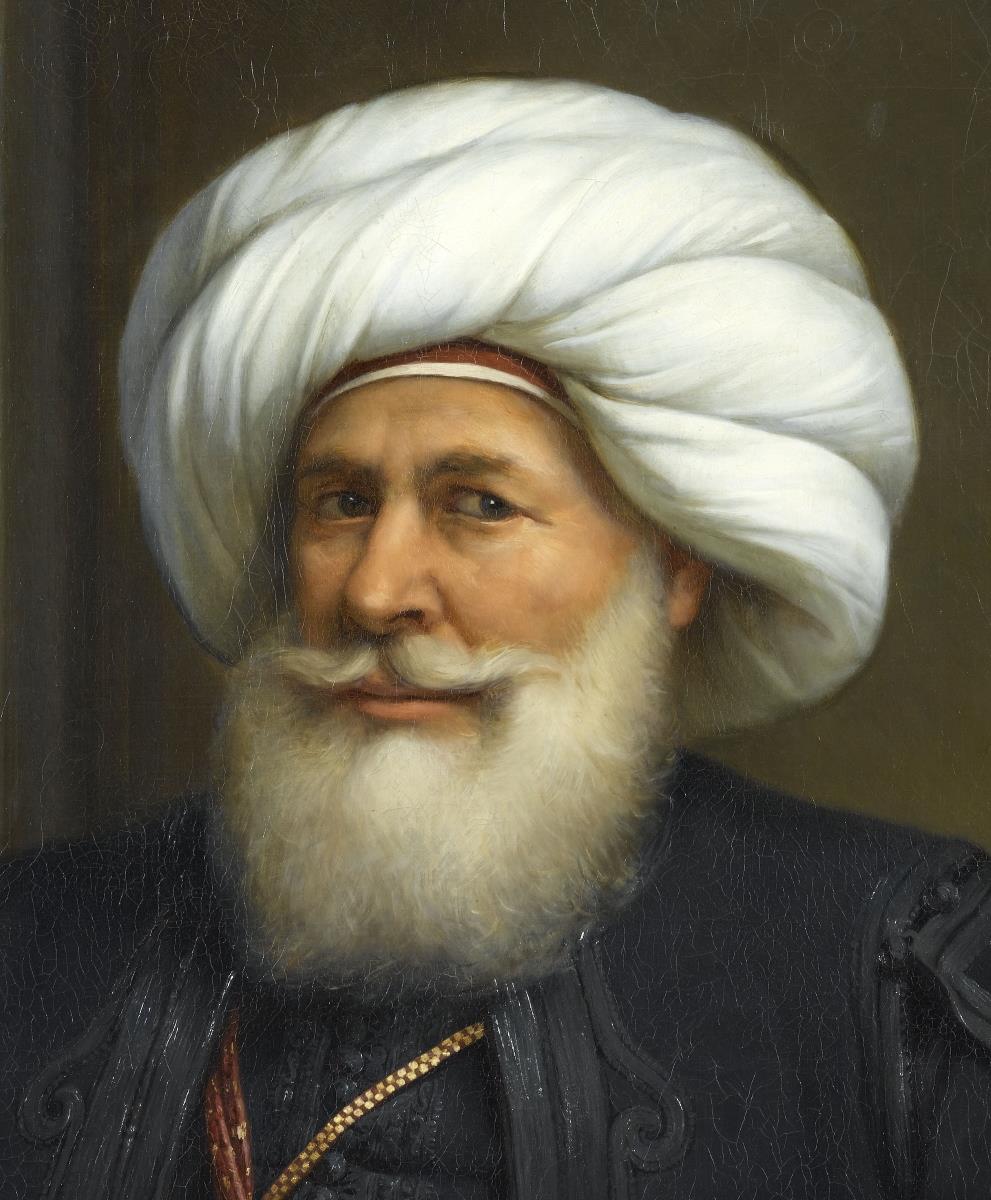 Quite notable in this regard was Muhammad Ali Pasha,
governor of Egypt (1805-1848). This Albanian-born Muslim reformer –
who in 1811 slaughtered off several thousand of the Mamluks who had
long governed Egypt – worked hard to bring up to European standards the
army and bureaucracy of Egypt (Napoleon’s activities in Egypt having
been the keen motivation for doing so). He also helped develop an
industrial economy able to support such an army. Soon, with the
introduction of cotton farming into Egypt, the country began to develop
independent economic and political power. Quite notable in this regard was Muhammad Ali Pasha,
governor of Egypt (1805-1848). This Albanian-born Muslim reformer –
who in 1811 slaughtered off several thousand of the Mamluks who had
long governed Egypt – worked hard to bring up to European standards the
army and bureaucracy of Egypt (Napoleon’s activities in Egypt having
been the keen motivation for doing so). He also helped develop an
industrial economy able to support such an army. Soon, with the
introduction of cotton farming into Egypt, the country began to develop
independent economic and political power.
In the process, Muhammad Ali established his own dynastic rule in Egypt
(which would last until 1952) ... creating the question of just exactly
how much was Egypt still a part of the Ottoman Empire. The British by
and large worked with his successors (now entitled "Khedives") as if
they were in fact fully sovereign heads of state, able to conduct
political policy in Egypt without consulting with the Ottoman sultan.
The Tanzimat. Meanwhile,
Sultan Mahmud II was keenly aware of the deficiencies of the Ottoman
government, and authorized a vast number of reforms of Ottoman
government and society in an attempt to modernize or reorganize
(tanzimat) the empire.5 French government provided the model for most of the reforms.
Yet whereas the hope of the sultans was to integrate more closely all
the various Ottoman sub-communities with the sultan's rule, the reforms
had something of the opposite effect, opening up to these
sub-communities the idea that they had their own sovereign rights to
develop as distinct peoples.
Thus a greatly weakened Turkey was beset by revolts of subject peoples
from within the Empire ... and assaults from without by surrounding
powers (principally Russia and Austria), attacks which steadily chipped
away at the outer borders of the Ottoman Empire.
Greece (1821-1832)
Then in 1821 it was the turn of the Wallachians (Romanians) to attempt a similar revolt. But it was put down by the Turks.
But the Wallachian uprising had inspired the Greeks of the
Peloponnesian Peninsula also to revolt at that same time. This
revolt, however, soon spread to the Greeks of Macedonia and the Island
of Crete.
Greek atrocities against Turks were answered by even greater atrocities
against the Greeks by the Turks (the Greek Patriarch hanged outside his
residence in Constantinople ... and 27,000 Greeks executed on the
island of Chios). This then prompted European involvement.6
Sultan
Mahmud then enlisted Muhammad Ali to send his army to Greece to crush
the rebellion. Muhammad Ali largely succeeded in this task (1825) ...
prompting Britain, France and Russia to intervene. In 1827 the three
powers finally sent their navies to break the Turkish-Egyptian hold on
Greece. This gave the small and struggling Greek Republic some relief.
But Mahmud would not back down ... until the Russian army took the key
town of Adrianople just north of the Ottoman capital at Istanbul ...
and a French expeditionary force was sent at the same time to the
Peloponnese (Southern Greece).
Bit by bit, protocols were signed by the Turks recognizing various
aspects of Greek independence ... until full independence was formally
acknowledged in the Treaty of Constantinople in 1832. The treaty also
established a monarchy for Greece, with Otto of Bavaria (actually a
minor at the time, and thus putting Greece under a regency until 1837)
becoming Greece's first king, replacing a short-lived Greek Republic.
His rule would face some difficulties in that Otto was a strong German
in his tendency to demand strict adherence to government rulings –
putting him in conflict with some of the more active former
revolutionary fighters – and was a strong Catholic in a very Greek
Orthodox world. But he did get Greece's independence secured for its
people ... although the Greeks could not get past the idea of
continuing the revolution until all Greek lands were out from under
Turkish rule, and the country had its capital back in Constantinople
(Turkish Istanbul). Troubles developed between the King and his very
popular former admiral Konstantinos Kanaris, with the blowup resulting
finally in Otto being forced to leave Greece in 1862.
Upon the urging of the major Western powers, the Greeks accepted Danish
prince George, who converted to Greek Orthodoxy and worked carefully to
win the support of the Greek people. He would reign as a very popular
king ... until his assassination by a crazed Socialist in 1913.
Serbia. Revolt
against the Turks had actually started earlier in Orthodox Christian
Serbia when in 1804 a peasant uprising, assisted by Christian Orthodox
Russia, was able to hold off efforts of the Turks to force Serbia
militarily back into the Ottoman fold. But in 1812, Russia was
being pressed deeply by Napoleon's army – thus pulled out of the game,
leaving the Serbs to face the Turks alone. For several years
Serbia was made to submit ... then in 1815 revolted again, this time
successful in holding off the Turks.
Finally in 1830 the Turks were forced to recognize Serbia officially as
an autonomous state, with the Serbian rebel leader Miloš Obrenović as
the new Serbian prince. ... ruling under a new constitution as of 1835.
4The
Janissaries had once (the 1400s and 1500s) been an elite fighting force
made up of slaves taken from their Christian homes as boys and raised
in both Islam and in a spirit of total devotion to the sultan.
They had no other stake in life and thus fought fiercely for the
sultan. But eventually (the late 1500s) the Janissaries were
allowed to marry, own property and have children of their own, becoming
something of an Ottoman aristocracy. They now had political
interests of their own to pursue ... and they soon became centers of
corruption rather than military discipline. The Janissaries grew
so powerful that they were able to make and depose sultans at will,
weakening greatly the sultanate.
5And
also did his sons, Abdül Mecid I (ruled 1839-1861) and Abdül Aziz
(ruled 1861-1876), who tried to keep their father's reforms moving
ahead.
6It
also inspired the British Romantic poet Lord Byron to go to Greece to
fight for its independence ... and die there of a fever in 1824!
THE GROWING SPIRIT OF REBELLION |
|
Germany
University students around Germany found themselves hopeful that a
united Germany might be established at the Congress of Vienna ... but
were disappointed at how Germany was ultimately split into three parts:
a strong Austria, strong Prussia and a weak Bund or German
Confederation. A number of student organizations (the
Burschenschaften) – calling for the creation of just such a unified
German fatherland – spread rapidly ... much to the distress of
Metternich. He called a congress of German princes to stand
together against this growing movement. They jointly issued the
Carlsbad Decrees, agreeing to curb the freedoms of the press and of the
universities ... even outlaw the use of the Burschenschaften's colors:
red, black and gold (the colors of Germany's flag today!). But
all that this achieved was the driving of the student movement underground
... which then became increasingly revolutionary. |

The march of the Burschenschaften to the Wartburg - 1817
... calling for a unified Germany
|
Spain
A similar problem developed quickly in Spain after the war.
Ferdinand VII had been removed from power by Napoleon in 1808 but
returned to his throne by Napoleon in 1813. At this point
Ferdinand turned into a bitter reactionary ... and what is considered
today Spain's worse king in its long history. He quickly
alienated the Spanish people by rejecting the liberal constitution of
1812 ... and then re-instituted the Inquisition, shut down all
newspapers except the official journal, and imprisoned or executed
every liberal voice in the country. And he seemed unable to work
with any other Spanish political figure, changing – and even arresting
– his ministers at frequent intervals.
Spanish
revolt actually started up first in the Spanish colonies in America
during the Napoleonic Era. Initially these revolts were
anti-French ... though liberal in political character. But with
the restoration of Ferdinand as Spanish king, the spirit of rebellious
liberalism began to turn against Ferdinand ... and take on the
character of independence movements aimed at securing the colonies'
freedom from Spanish authority. Then the spirit of revolt
extended to Spain itself in early 1820 among Ferdinand's troops that he
had assembled in Cadiz with the intention of sending to America to
suppress the colonial rebellions going on there. Ferdinand lost
the contest with his troops and was thus forced to accept the liberal
constitution of 1812.
But another meeting of the Concert of Europe was called by Metternich,
where it was finally decided to authorize the French to invade Spain
(1823) and restore the absolute rule of Ferdinand. In this France
succeeded, ending for a while all open talk of liberal reform of Spain.
The continuing independence movement in the Americas
Haiti. The French
Revolution and its strong political ideals infected deeply the
inhabitants of the French sugar-producing colony (known at the time as
Saint-Dominique) ... inhabitants made up mostly of slaves brought
generations earlier from Africa to work those extremely profitable
sugar plantations.
Unfulfilled promises of freedom sent back and forth between
revolutionary France and Haiti finally inspired a group of mostly Black
freedmen in 1791 to take up their own cause of liberation (ending
slavery altogether) ... beginning a revolt that would brew through the
next ten years – led by the militarily talented Toussaint
Louverture. Indeed, slavery was pronounced at an end in 1794,
confirmed by the subsequent Directorate, and then also by
Napoleon. But the actual status of the colony itself remained
uncertain ... especially as Louverture switched back and forth in his
loyalties to France (partly shaped by political intrigues going on
within Haiti itself).
Napoleon moved in 1801 to resolve the matter by sending a huge force to
Haiti to bring the colony back under full French control ... and by
having Louverture and his colleagues arrested and deported to France in
the process. But the Haitians fought on, led by Louverture's
lieutenant Jean-Jacques Dessalines ... the Haitian effort aided greatly
by a huge outbreak of yellow-fever, which decimated the French
army. When in 1803 the French were defeated in a battle at the
end of the year, it was clear that French rule in Haiti had come to an
end.
Indeed, Haiti now came under the firm rule of Dessalines, who butchered
the remaining French White and most of the freed-Black population in
Haiti (a total of 3,000 to 5,000 executed), and then became Haiti's new
emperor. But he himself was assassinated in 1806! Thus it
was that Haiti set off down its own quite peculiar path ... one often
very brutal in nature.
Mexico. When
Napoleon invaded Spain in 1808, deposed the Spanish king Charles IV and
placed his own brother Joseph over Spain as its new king, the Spanish
colonies in America found themselves in a state of political
confusion. At first it appeared that the huge viceroyalty of New
Spain (as the Spanish colony was termed at the time) was going to come
under the independent governance of a group or junta of local leaders
... except that this was blocked by those (usually those originally
born in Spain) with continuing Spanish loyalties.
But then a call to revolt issued in 1810 by a local priest, Father
Miguel Hidalgo y Costilla, was taken up enthusiastically by locals ...
and a contest between the pro-Spain and pro-independence supporters
broke out ... brutally – both sides executing captured opponents,
including Father Hidalgo, who was executed in 1811. A Declaration
of Independence was issued formally in 1813 ... but the civil strife
within New Spain continued nonetheless.
In 1820, when Spanish Liberals were able to take control in Spain, the
question of the status of the Catholic Church and the matter of a
republic or a monarchy to govern Spain and its overseas holdings merely
intensified the struggle in New Spain. Finally in 1821, a
compromise was agreed on in New Spain (now giving itself a local name
as "Mexico") between the leaders of the two parties – declaring Mexico
independent and all citizens now of equal status politically ... but
Catholicism still the sole religious underpinning of the country and
monarchy as the ongoing form of government. The monarchy was,
however, very soon replaced by a republic of sorts.
So Mexico was independent. But what it was beyond that was never
very clear. The military stepped in frequently to resolve
personal contests at the top of the political hierarchy – making for
very unstable governance ... a problem that seemed never to go
away!
Central America. At
the same time the Spanish lands to the south of Mexico, set themselves
up separately from Mexico as the Federal Republic of Central America
(1823). But the different regions making up the federation fell
into civil war in 1838 – liberals versus traditionalists, eventually
joined by just "separatists" in the fight. But by 1841, everyone
was exhausted ... and the federation was ended – with Guatemala,
Honduras, Nicaragua, El Salvador, and Costa Rica acknowledged as fully
independent countries.
Simón Bolívar and his Republic of Colombia (Gran Colombia).
Much the same dynamic was going on further south, in Spanish
territories located in the northern part of the South American
continent. Again ... the French Revolution and Napoleon's role in
upsetting deeply Spanish government both home and abroad played majorly
in the developments in this region. But here a single individual,
Simón Bolívar, played the key role of being the central figure in these
events.
In 1810 Bolívar took up fighting in support of a Venezuelan republic
that had declared its independence from Napoleonic Spain. At one
point (1815) he was forced to flee to Haiti, but returned with Haitian
support and was eventually (1821) able to set up a new Venezuela
republic ... actually entitled the Republic of Colombia – with Bolívar
quite naturally serving as its president. But he did not stop at
that, but kept up his conquests by liberating other lands in the region
– Ecuador (1822), Peru (1824) and Bolivia (1825). These were then
merged into what was termed "Gran Colombia."
However political differences developed between Bolívar (a strong
centralist) and former supporters who wanted greater autonomy in the
regions ... ultimately even independence on the part of Venezuela,
Colombia, Ecuador, etc., that made up Gran Colombia. In the
dispute, he lost control of those regions, was nearly assassinated
(1828), and – tired of the whole mess – finally resigned (1830) ... and
soon died.
But here too what followed was simply government by various
military-supported autocrats (caudillos) ... who, however, would never
attain the respect and authority that Bolívar had possessed. But
it was all the government that these new states were to know ... for
the longest time (even up to today).
Brazil. As a
colony, Brazil played a role quite different from that of the Spanish
colonies when in 1807, to escape Napoleon's aggressions, the Portuguese
Prince Regent João (or John) VI moved himself and his court to Brazil's
Rio de Janeiro ... making Brazil the center of Portuguese
operations. And in doing so, João went on to develop Brazil's
political institutions to a rather high degree of sophistication.
And then, to the great irritation of the Portuguese back home in
Portugal, when the Napoleonic threat was over in 1815, there seemed to
be little interest in the royal court in leaving the vast lands of
Brazil to retake residence in the much smaller Portugal. The idea
of making Brazil and Portugal co-equals in the Portuguese political
system did not please the domestic Portuguese either.
But the Liberal Revolution in Portugal (1820) brought to power those
able to force João to return to Portugal to resume rule there
(1821). Nonetheless, he left his son Pedro to continue as Regent
in Brazil. Then also, when the Portuguese revolutionaries tried
to return Brazil to the status of being a mere Portuguese colony ...
the Brazilians resisted strongly – led by Pedro. The following
year (1822) the Brazilians then made their country a fully independent
"Empire" ... with Pedro as their emperor. But Portuguese military
efforts to counter this move did not work well ... and the Portuguese
court finally (1826) recognized Brazil as being fully independent.
Of course independent Brazil faced some of the same contentious issues
as the newly independent Hispanic states around them: liberalism
versus traditionalism. Keeping Brazil from falling into civil war
exhausted Pedro, who died in 1831 ... leaving Brazil in the hands of a
Regency while his son remained in his infancy. Unsurprisingly,
the political turmoil merely continued during this period.
Finally in 1841, Pedro II was crowned ... way before his adult years.
But overall, Brazil prospered and remained fairly stable politically
during the 58-year reign of Pedro II ... until in 1889 the Brazilian
military conducted a coup, establishing a Brazilian republic.
The Monroe Doctrine (1823).
Meanwhile (going back to the 1820s), during all this turmoil brought on
by the French Revolution and Napoleon's Empire, there was no way that
either Spain or Portugal were ever going to allow the independence of
their colonies ... and thus they both fought back fiercely against the
independence movements going on there.
But all of this confusion had allowed the very entrepreneurial British
to quietly slip into the American dynamic ... to develop strong
commercial ties of their own with these colonies. Thus Britain
had no intention of ever letting their American clients be drawn back
into the mercantilist privileges7 of Spain and Portugal.
But, most cleverly, the British let the American President Monroe state
the case for both Britain and America in this matter: America
would not let any European power restore its colonial empires on its
side of the Atlantic. That might have appeared as an incredibly
stupid pronouncement coming from a very recently established and
untried republic. However ... it was well understood by all that
the might of the British navy was what stood behind this "Monroe
Doctrine" (1823), giving it its muscle.
7Mercantilism: where colonies were permitted to trade only with the imperial mother country ... and no one else.
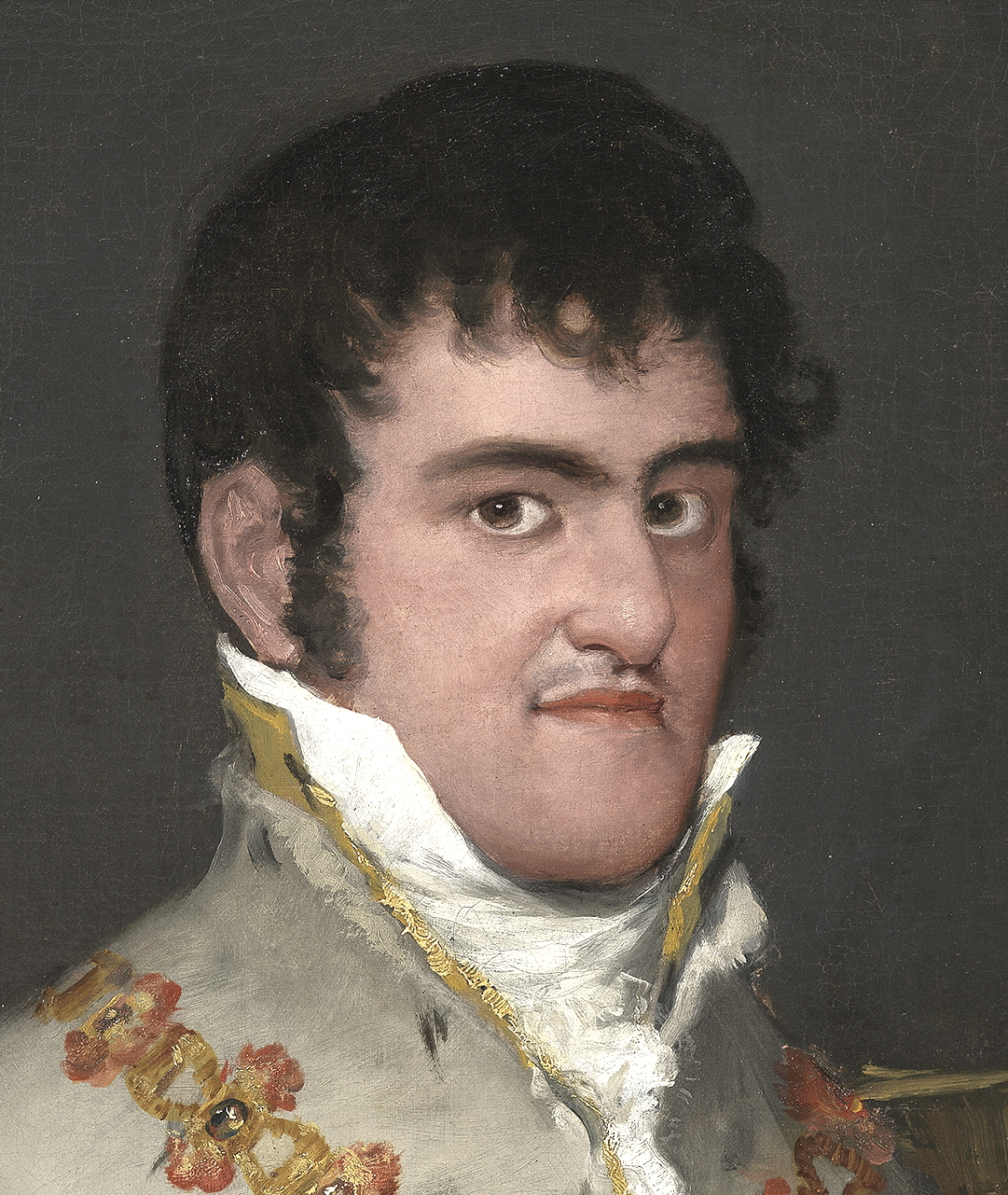
Ferdinand VII of Spain (ruled briefly in 1808 and then 1813-1833)
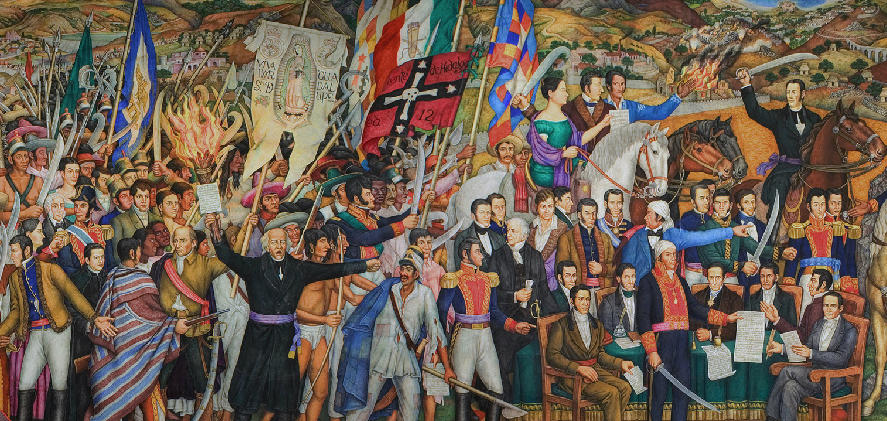
September 16, 1810 - Father Hidalgo begins the Mexican independence movement
(completed in 1821)
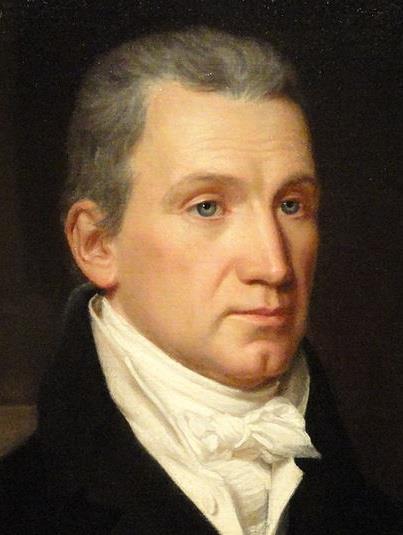
American President James Monroe - author of the "Monroe Doctrine"
protecting Hispanic-American independence from a Spanish reaction
(actually backed up by British naval power)
At
this point the sole agenda of the Congress of Europe – now including
only Austria, Russia and Prussia as its mainstay – was the defense of
the autocracy of these three powers. But that was going to come
under increasing challenge from liberal quarters.
France
Unsurprisingly, there had existed in France a very anti-Revolutionary, anti-Napoleonic mood amidst
the returned nobility ... and even in some parts of the French
countryside. Louis had tried to walk a line of moderation between
those French with fond memories of the Empire and those French with a
burning hatred for everything and everyone Napoleonic. But he was
old and sick ... and up against his younger brother, who was a leader
of the anti-Napoleonic reaction. Worse, Louis had no heirs
himself and it looked as if the throne would pass to his younger
brother upon his death.
Indeed, only ten years on the throne, Louis died in 1824 ... and his brother Charles X became France's king. Unfortunately, Charles was too thick-headed
to understand what his older brother had understood ... and proceeded to try to move the Bourbon monarchy back
to the status it possessed prior to the Revolution. The only
people this would please was the small group of ultra-royalists among
the returning émigrés. But Charles's actions greatly alienated
much of the rest of French political society – a large section of
France comprising the middle and upper middle class ... and the citizens
of Paris of all social orders.Finally bringing things to an explosive head, Charles foolishly
responded to the growing opposition to his rule by publishing the "July
Ordinances" of 1830, which dissolved a newly elected Chamber of
Deputies (which had returned an even larger number of liberals opposed
to Charles), and called for new elections ... allowing only a very
small number of voters to participate. A number of Paris
journalists protested his move ... and were soon joined by a Paris mob
filling the streets. Soldiers sent out by Charles to suppress the
mob were attacked savagely by the protesters ... with many soldiers
soon joining them.
Fearing that all of this was heading toward a restoration of Republican
France, French political leaders Talleyrand8 and Thiers put before the
Chamber of Deputies the name of Louis Philippe, Duke of Orleans, as a
new king to replace Charles X (who was forced to step down) ...
entitling him as "king of the French by the will of the people" (rather
than the old Bourbon formula: "king of France by the will of
God"). Thus the Orleanist wing of the old Bourbon monarchy took
power in France ... with Louis Philippe I posing himself as the
"bourgeois king" (mostly an act!).
The uprising (which had never extended outside of Paris) quickly
settled down. Overall the French were enjoying a period of rising
prosperity brought on by the fifteen years of peace and were now
relatively content with the shape of things politically in France.
8Although
this period is known as "the Age of Metternich," Talleyrand was himself
a most outstanding individual in the field of European politics during
this same period. He began his political life as a Catholic
priest, representing the Church in the court of Louis XVI. He
represented the First Estate (Church) in the Estates-General of
1789. Then, becoming anti-clerical, he joined the Jacobins!
He was sent to England in 1792 to represent the new French Republic ...
and remained there when France began moving toward the Reign of
Terror. He was forced out of England in 1794 and went to America,
staying there for two years. The new Directorate permitted him to
return to France ... and then appointed him as its Foreign
Minister! But he soon became a supporter of Napoleon, aiding
Napoleon in taking control of France from the Directorate. And
thus he became Napoleon's Foreign Minister! But his relationship
with Napoleon cooled when he found himself disagreeing with some of the
Emperor's diplomatic decisions, and he resigned his position in
1807. Then in 1814, Talleyrand played a key part in the
restoration of the Bourbon monarchy ... and was appointed as France's
chief negotiator at the Congress of Vienna. However for the
next fifteen years he stepped out of the limelight of French
politics. But he re-entered the spotlight in arranging for
Louis-Philippe to take the French throne in 1830.
Today his name mostly evokes the image of a cynical, self-serving
politician willing to pull almost any deal that would advance his
career. But actually it was the gain of France that seemed to
inspire most of his craftiness ... behind and above all else that he
did.
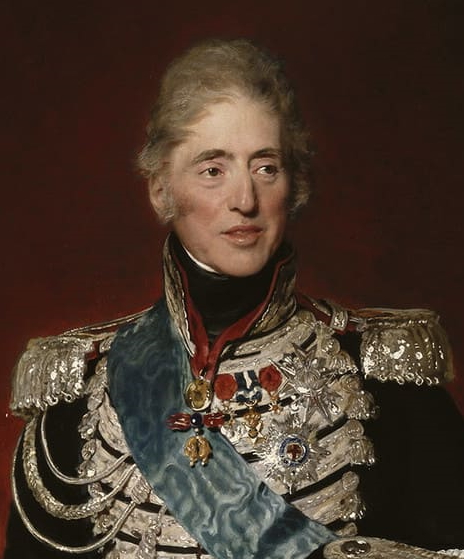
French King Charles X (reigned 1824-1830)
 Eugène Delacroix –
Liberty
Leading the People (1830) oil on canvas - commemorates the July Revolution
of 1830
Eugène Delacroix –
Liberty
Leading the People (1830) oil on canvas - commemorates the July Revolution
of 1830
Paris, Musée du Louvre
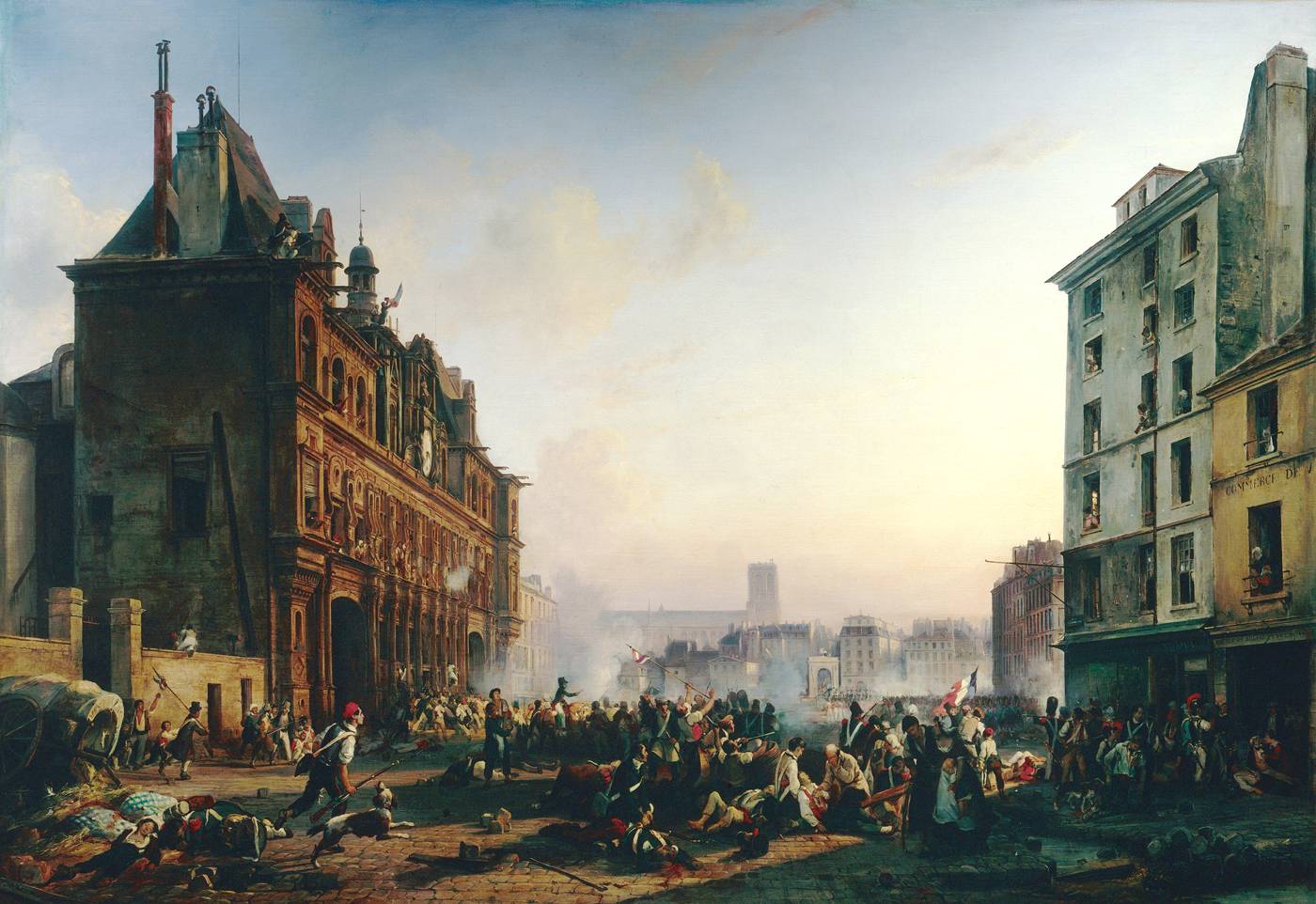
Events at
the Hôtel de Ville (left) during the July Revolution – Joseph Beaume

"Citizen-King" Louis-Philippe
of France (reigned 1830-1848) - by Franz Xaver Winterhalter - 1841
The King is depicted at
the entrance of the Gallerie des batailles
which he had furnished in the
Chateau de Versailles.
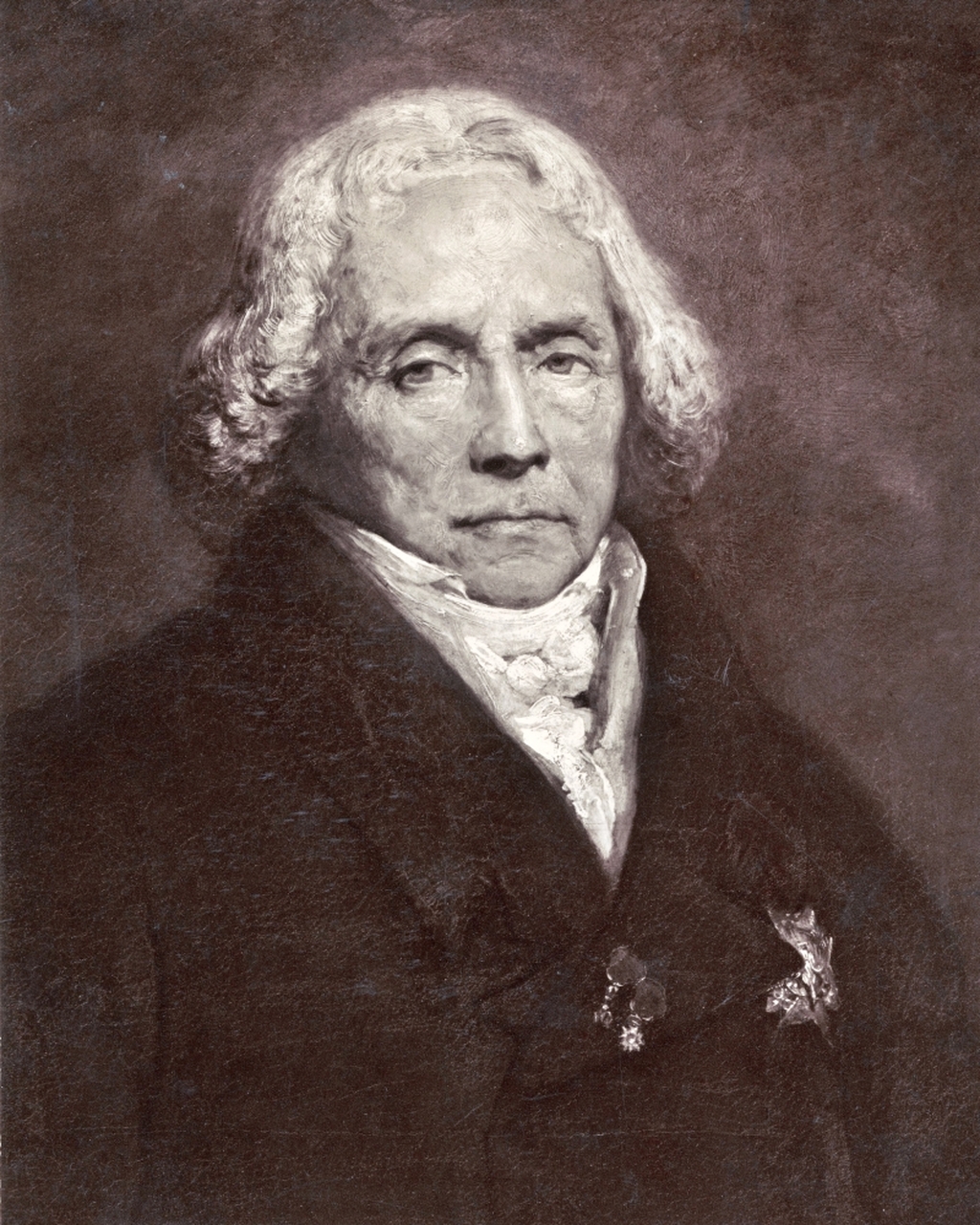 An older Talleyrand (Charles Maurice de Talleyrand-Périgord
An older Talleyrand (Charles Maurice de Talleyrand-Périgord

Adolphe
Thiers – French Prime Minister
(1836-1839)
|
Belgium
The people of the southern provinces of the new Kingdom of the
Netherlands had, in earlier generations, been brought back forcibly to
Catholicism. This alone made them quite different from their
heavily Protestant northern neighbors. Also, the upper and middle
classes of this region spoke French rather than Dutch ... and were
greatly upset when their new king, William I, demanded that all
government work be done in Dutch (exempting only the French-speaking
Walloon districts bordering France).
William's high-handed ways so upset these "Belgians" that in August
(partially inspired by events in nearby Paris) protesters took to the
streets of Brussels as a result of an opera which stirred Belgian
feeling to a point of high indignation. Soon a street mob
developed, and began looting and pillaging the city through the
night. A group of alarmed citizens formed a Council of Regency
and proposed a separation of Belgium and Holland, with the king's
brother as viceroy of Belgium. William reacted to this challenge
by sending an army to Brussels ... which ran into such stiff resistance
that it was forced to withdraw. William was now willing to agree
to the Council's proposal. But it was too late. A
Provisional Government had been formed in Brussels.
At this point the other powers of the Concert of Europe weighed in on
the matter ... Prussia and Russia ready to invade, but France's Louis
Philippe threatened to counter their move. At a meeting in London
the Big Five powers called for an armistice ... then moved to recognize
Leopold of Saxe-Coburg as the king of Belgium. The Dutch
nonetheless sent an army to Belgium ... only to be countered by a
French army and a British-French blockade of the Dutch coast.
William now had lost the contest. But it would not be until 1839
that he would finally recognize the independence of Belgium.
|
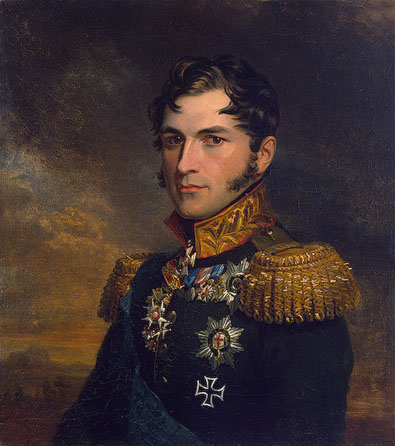
Leopold Saxe-Coburg dressed as
a Russian general – by Geo Dawe (1823-1825).
Later, he become "Leopold I – King of Belgium" –
1831-1865;
he is also the uncle of Albert, Prince-Consort
of England (his nephew Albert is married to Queen Victoria)
St-Peterburg, Winter Palace
War Gallery
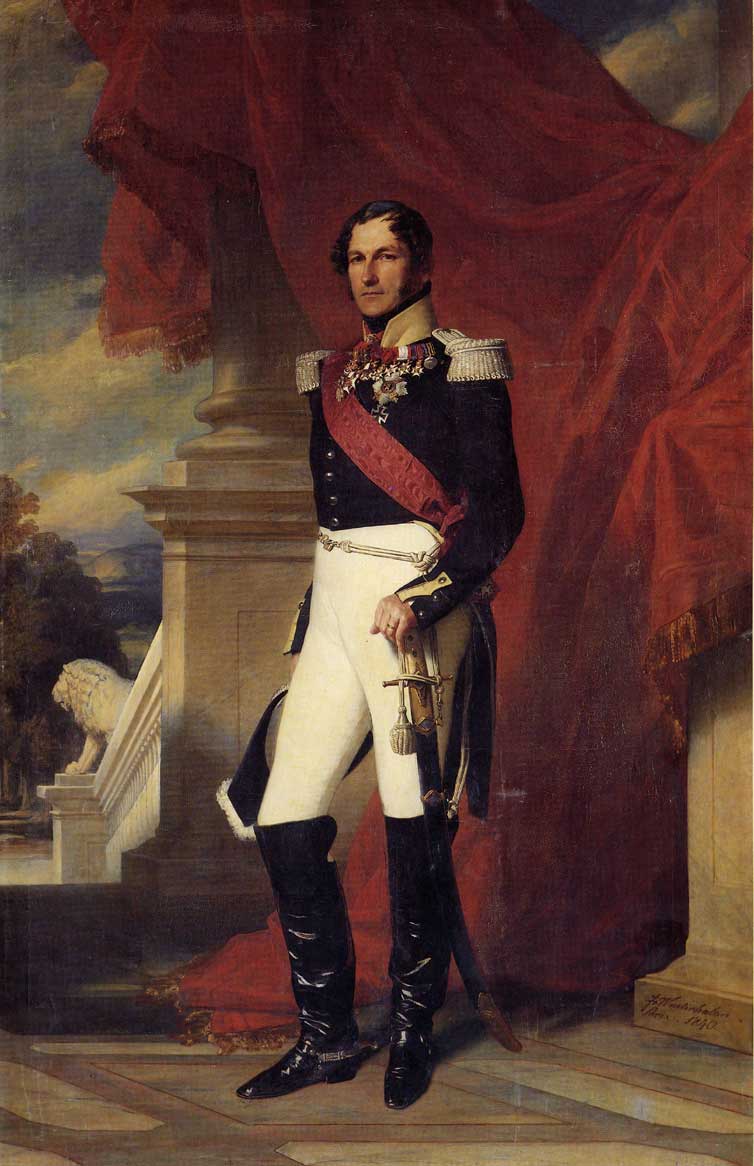
King Leopold I of Belgium
by Franz Xaver Winterhalter - 1839
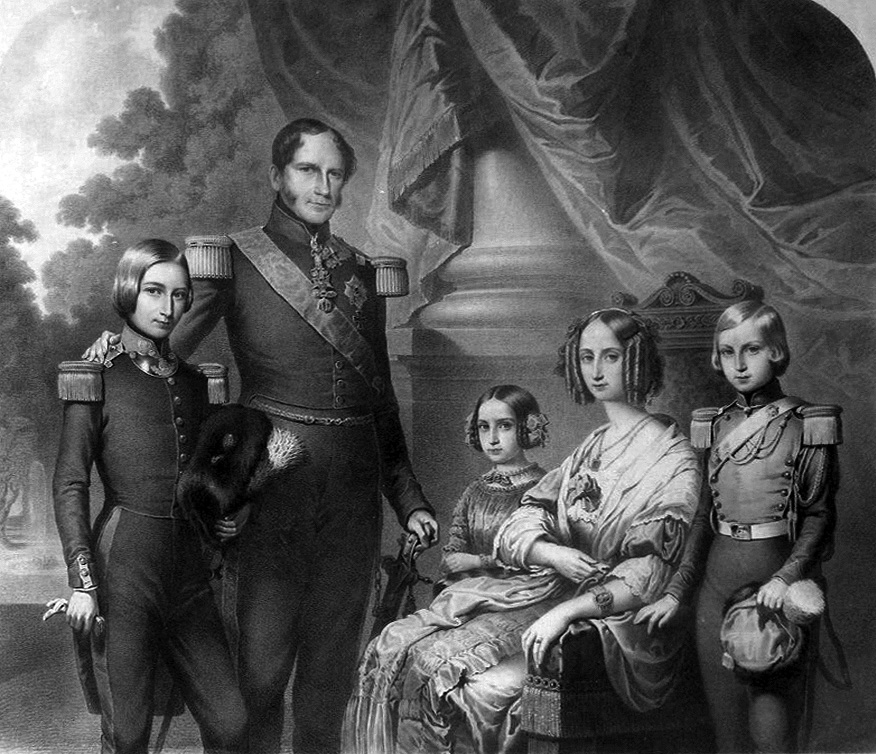
Leopold I and family: Queen Louise-Marie, Crown
Prince Leopold, Prince Philippe, Princess Marie-Charlotte
|
Poland
Not every such event in Europe ended up so successfully. Poland
had once been a powerful society (1500s and 1600s) but decline had set
in during the 1700s and the Poles found their society carved up in
three different stages of partition (1772, 1793 and 1795), being
completely absorbed or "disappeared" by the surrounding major powers,
Russia, Prussia and Austria with the last partition. But Polish
patriots fought alongside Napoleon in his wars against those same three
powers ... and Napoleon rewarded Polish support in 1807 by setting up a
Duchy of Warsaw. But at the Congress of Vienna in 1815 the duchy
was re-designated as a kingdom ... with the Russian Tsar as its king!
At first Alexander respected the more liberal character of the Polish
society and state, even allowing the Poles to continue to keep their
own flag, currency, military uniforms, and particular political
organization. But as Alexander turned more conservative – even
reactionary – he began placing tighter restrictions on Polish
society. When his brother Nicholas I took the Russian throne in
1825, he at first attempted to relax the restrictions ... until an
attempt on his life in 1829 turned him also towards repression of the
people under his rule.
Towards the end of the following year the 1830 spirit of rebellion
spread to Warsaw, then to the whole of Poland. At first the Poles
were able to hold off an invading Russian army. But the Poles'
own lack of a unified command structure undercut their effort and in
1831 Warsaw fell to the Russians, ending the revolt. At this
point Nicholas declared the Polish monarchy expired, with Poland now
simply absorbed into the Russian state. However, although this
stopped Polish independence activity, it did not end the Polish dream
of national independence. In fact it served in the coming years
to make the dream even stronger in the hearts of Polish nationalists.
|

The Partitioning and official disappearance of Poland (in different stages)
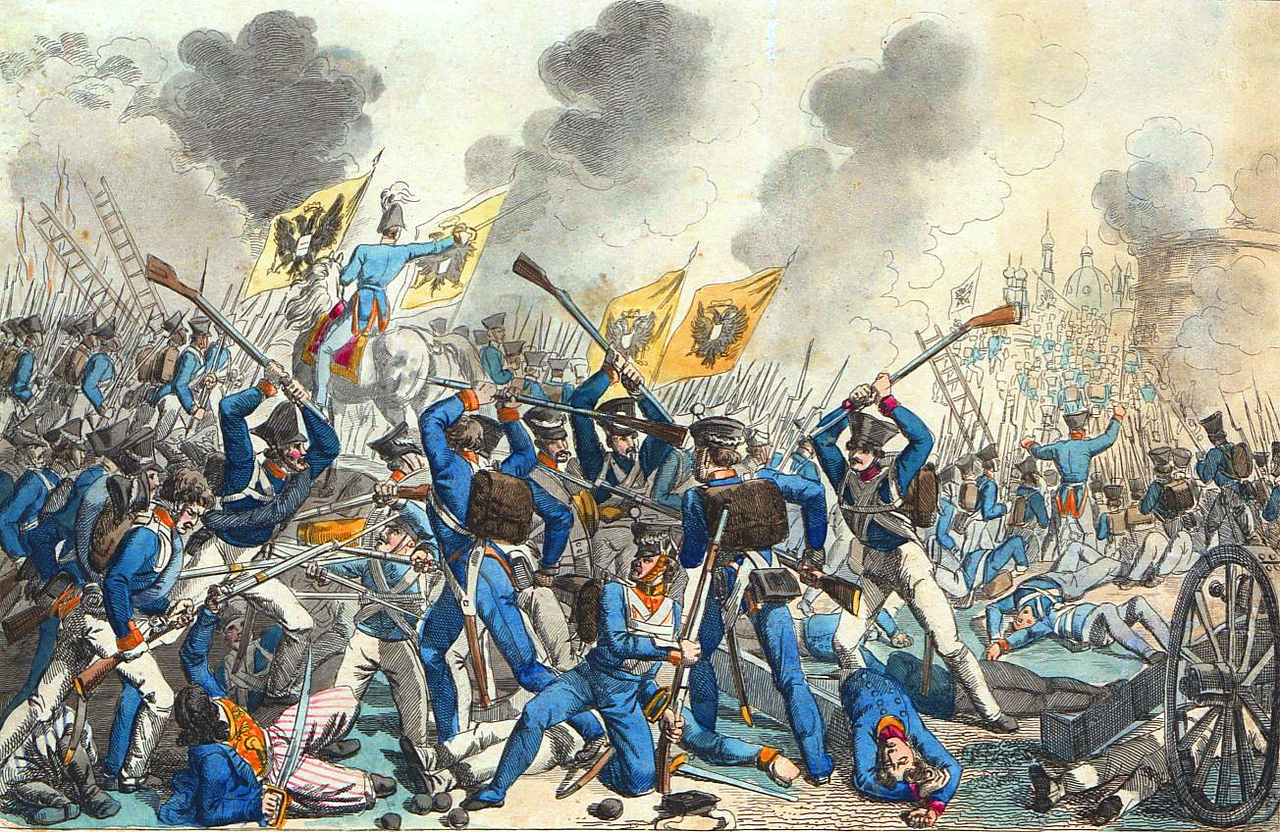
The Russian attack on the Polish forces at Warsaw - 1831
|
Political reform in Great Britain
Whereas the House of Lords was made up of high Church officials and the
British aristocracy, the House of Commons supposedly was a more
"democratic" part of the British Parliament. Since even the
Middle Ages, two members were elected from each of the counties and
towns (boroughs) making up the kingdom. But over the centuries
economic fortunes had changed and many of the towns had disappeared,
yet still sent two representatives to Parliament ... whereas major
industrial centers that had grown up in the past century (Manchester,
Birmingham, etc.) had no representation whatsoever. Furthermore a
few landowners of the empty boroughs (‘rotten boroughs') controlled a
number of seats; other seats were bought and sold like clothing
goods. The whole system therefore actually ended up representing
only a tiny portion of the entire British population.
With the democratic spirit spreading across the European continent in
1830, the mood soon reached the British shores as well. In 1830
the unloved George IV died and his place was taken by his more
liberal-minded brother, William IV ... who called for election, which
brought to power a reformist Whig majority led by Earl Grey.
After much action back and forth, a reform bill was finally passed into
law in 1832. It wiped out the rotten boroughs, gave new
representation to the industrial cities and made voting standards
uniform across the kingdom. It increased the suffrage, bringing
the comfortable middle class into the voting public ... though it still
set voting qualifications high enough that it excluded the multitudes
of industrial and farm workers making up the bulk of the British
population. Nonetheless, this marked a significant step forward
toward full democracy in Britain. |
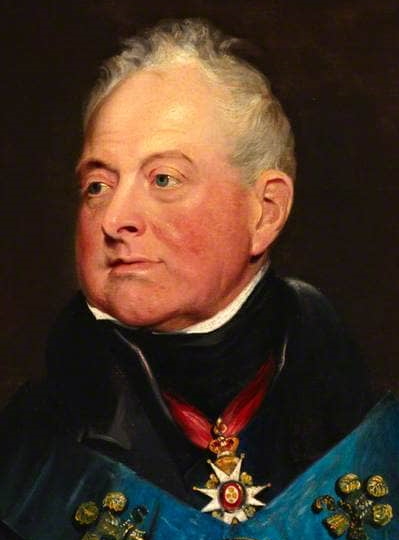
William IV (ruled 1830-1837)
|
The expansion of "Democratic America"
The Jacksonian "Democratic Revolution" (the 1830s).
The vote of the common people (at least for members of America's House
of Representatives) was not a new thing for the Americans. But
with the development of Andrew Jackson's Democratic Party (shaped and
directed in its activities by Jackson's assistant, Martin Van Buren),
America was understood to be led no longer by aristocrats (particularly
the Virginians – Washington, Jefferson, Madison and Monroe) or the
Bostonians (the Adams, father and son) ... but by "one of the people" –
Andrew Jackson. Actually, Jackson was himself of aristocratic
background ... but played to the idea that he was just an ordinary
American. And indeed ... the common people, muddy boots and all,
invaded his presidential reception in 1829 (smashing dishes and
furniture in the process) to get close to their war hero and now
president, Andrew Jackson.
And so a new understanding filled the political atmosphere of America
... certifying the fact that politics belonged to the people themselves
... and not just a group of select aristocrats. Politics could
thus get very vulgar at times ... part of its being so
"democratic"! But America was very proud of itself in taking the
lead in this matter of "democratizing" their society's politics.
The "Second Great Awakening."
Behind this peculiar self-development of "Democratic America" was a
renewing of the popular spirit … one that had guided America through
the dark days of its war of independence from British King George
III. But this was a spirit then that had, like most things when a
crisis is over, settled back into a more mundane nature – a humanistic
spirit that sees itself guided by reason and logic rather than
unpredictable passion … and unpredictable sources, such as God himself.
The French found this American spirit most interesting, because it was
so different from what was the norm back in Europe. This
curiosity brought Alexis de Tocqueville and his associate Gustave de
Beaumont to America in 1831 to study America more closely. Then
in 1835 and 1840 Tocqueville published his two-volume findings, Democracy in America,
noting not only the basically egalitarian spirit of the American people
(easily challenging those who would take on airs of superiority),
something he understood derived from America's basically Puritan
origins. He also noted the restless and purpose-driven heart of
the American individual – who however (from his point of view) tended
to move on to new challenges before completing the old ones! He
also was most alarmed at how the slavery issue was crushing the
American soul, predicting (correctly) that failure to soon resolve this
issue would most likely lead to civil war in America.
But the American world of cool reason and logic supposedly
characteristic of the comfortable Americans soon came under
attack. A huge economic depression that hit America in the period
1837-1841 undercut deeply the idea that life basically worked along
quite rational lines. Such an event seemed at the time to be
unprecedented. Thus, even in the East, talk grew that America was
facing God's great Day of Judgment, the long-awaited return of Christ
to Earth – to judge all humankind. Americans needed to get their
act together spiritually.
Also … apparently masses of Americans, especially those that had
crossed the Appalachian Mountain Barrier and were heading ever-deeper
into Indian territory, were not seeing things in America's supposedly
humanistic fashion. Here on the Western frontier, hunger,
disease, and angry Indians awaited these bold souls willing to step
into such an unpredictable world. But comforting them was their
strong Christian faith that they were answering a call that God himself
had put on them … a covenantal call to advance their Christian realm
into the darker world of the American interior. And they
understood this challenge as one calling them to deal with this world
in front of them but also the world within themselves. They
needed to cleanse themselves of their own sins so that they could find
greater success in taking on this larger life – and ultimately get
themselves right with God.
To cultivate and direct this strong American spirit was a range of
individuals, most of them simple men who took up the call to pastor
(preach, teach, baptize, pray) the wide-ranging collection of
frontiersmen and their families. But a large number also were
just as active in the more settled East. There were also a number
of "prophets" who stepped forward to offer "updated" versions of the
Christian gospel, also collecting a huge following in the process.
By far the most active were the Methodist circuit riders, who braved
weather, hunger, and Indians to reach the scattered settlements of the
frontiersmen with their preaching and counsel. These were
ordinary men with extraordinary commitment, fueled by a religious fire
that actually started back in England at the turn of the century and
had been brought to America under the guidance of America's Methodist
Bishop Francis Asbury, a man himself who in a period of 1784-1816,
preached some 16,000 sermons over a course of as much as 275,000 miles
on horseback, and who grew the American Methodist community from 1,200
to 214,000 – with eventually 700 preachers to guide this huge
flock. He was followed by an even greater number of circuit
riders, some 3,500 of them, and nearly 6,000 Methodist pastors, who by
1840 had this community up to 750,000 members in size, the largest
denominational community in America.
Even the Black community got in on the act, with the African Methodist
Episcopal (AME) and AME Zion communities developing among free Blacks
in Philadelphia and New York City. These two groups would play a
huge role after the Civil War (1861-1865) in shaping the religious
lives of the multitudes of newly freed slaves.
And the folks back East were also invited to the world of camp
meetings, largely designed by the Presbyterian pastor Albert Finney,
who turned these meetings into well organized "revivals," ones that
would become something of a model for other revivalists – in his days
and even since then. So active was his revivalist ministry
that it seemed that there was no more work to be done in up-state New
York. It had become, what Finney himself termed, "a burned-out
district"!
Then there was the most unusual development with the up-state New
Yorker William Miller, who was able to bring a huge number of followers
to purify themselves in preparation for the "Advent" or Second Coming
of Christ ... which he predicted would bring the "Rapture" in April
(then October) of 1844. But disappointment did not discourage his
followers – who reformed themselves under the guidance of the female
prophet Ellen White as the "Seventh-Day Adventists," a group that would
grow internationally as well as nationally.
Also arising from the same "burned-out district" of New York was an
even stranger quasi-Christian movement: The Latter-Day Saints, or
"Mormons." Its founder Joseph Smith claimed angelic direction
(1827) in getting his new religious movement started up, complete with
its own Bible (The Book of Mormon)
and its own way of preparing for the second coming of Christ. But
so radically different was his "Mormonism" that his movement not only
grew monumentally in size, it succeeded in stirring up equally
monumental opposition from Christian neighbors. Thus he had to
move his huge community several times, before he himself was killed in
another such confrontation (1844). Ultimately a member of his
staff, Brigham Young, took the bulk of the Mormon community (there
would be other communities elsewhere as well) all the way to Utah, and
there set up his "Zion" headquarters for what would become a huge
international religious community.
There was, however, a calmer version of America's Second Great
Awakening, arising amidst the more traditional American denominations
... principally the Congregationalists, Presbyterians, and Dutch
Reformed, although many Methodists (and Baptists) would soon join this
development. Two areas of action grew huge within these Christian
communities: the founding of colleges to further the world of
Christian knowledge and the creation of missionary societies to spread
the word – even abroad. Thus it was that jointly these
communities created the American Bible Society (to put a Bible in every
American home), the Sunday-School Union (to develop Biblical literacy
among America's children and youth), the American Tract Society
(offering an easy explanation of Christianity's basic themes and
doctrines), etc., etc. Equally amazing was the number of
Christian seminaries and colleges that were established during this
period, some 500 of them by the mid-1800s.
Literacy and knowledge were never intended to be the privilege of just
the upper ranks of society - as was the case back in Europe. This
was a privilege available to any American seeking such a goal in
life. America's democratic sense of the basic equality of all its
people depended on such opportunities being available to one and
all. You would have to work for it. Equality would not just
be handed to you on a silver platter. But it was there, freely
available to any and all who sought it. And Americans were
definitely just such seekers!
And that was America spiritually in the 1830s and 1840s!
The Mexican-American War (1846-1848).
Indeed, it was the urge of the American people themselves rather than
the designs of any government that had long been the foundation of
America's birth, growth and ultimately substantial national
power. And this democratic instinct driving America was not
likely to weaken ... as long as there was land to the West for
Americans to settle.
Texas would play a particularly key role in this matter at this point
(1830s) ... as thousands of Americans poured into what the neighboring
Mexicans viewed as a northern province of theirs (but sparsely
inhabited by Mexicans themselves at the time). Ultimately this
American "intrusion" brought war between the two groups ... with the
Texas-Americans soundly defeating the army of Mexican caudillo Santa
Anna in 1836. Mexico was thus forced to acknowledge Texan
independence.
But then the matter arose as to whether Texas would stand as an
independent nation or as an add-on to the United States, with the
Texans soon resolving the matter in favor of the latter. But this
presented a huge problem for the U.S. government... fully understanding
the outrage that Mexico would feel if Texas were to join the Union.
After being avoided as an issue by American presidents for the next ten
years, President Tyler and the U.S. Congress moved finally (1846) to
accept Texas's request for admission to the Union ... bringing Mexico
to immediately issue a formal declaration of war against the U.S.
But to the surprise of everyone (including most Europeans) the Mexicans
were quickly and decisively beaten in various battles ... not only in
Texas but in all of Mexico's northern territory – reaching even to
California. In fact, by September of 1847, American troops found
themselves fully in command of Mexico.
Thankfully both Congress and President Polk were wise finally to award
Mexico a $15 million payment for the territory taken from Mexico,
softening the blow greatly ... and gaining formal Mexican acceptance of
the transfer of lands. This piece of diplomacy would soon prove
to have been very, very important ... for in short order, defending the
American claim to these Western territories in the face of a Mexican
counter-move would have made a huge crisis hitting America at the time
(the American Civil War, 1861-1865) all the more disastrous for the
American Union.
|
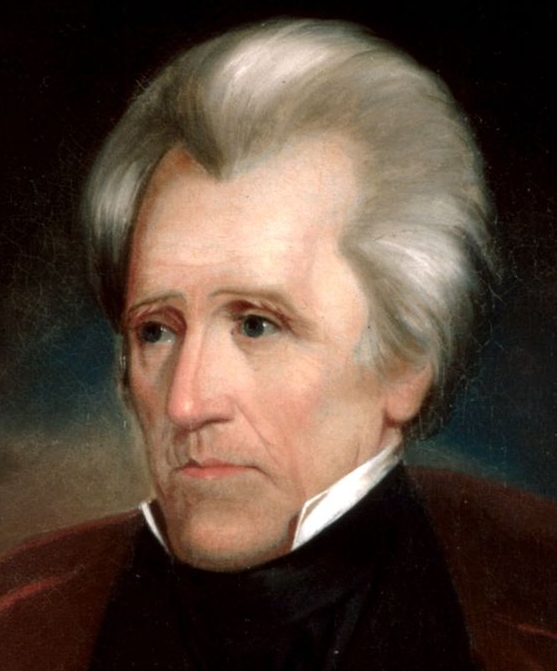
Jackson (President 1829-1837)

Martin Van Buren

Jackson's presidential reception - 1829
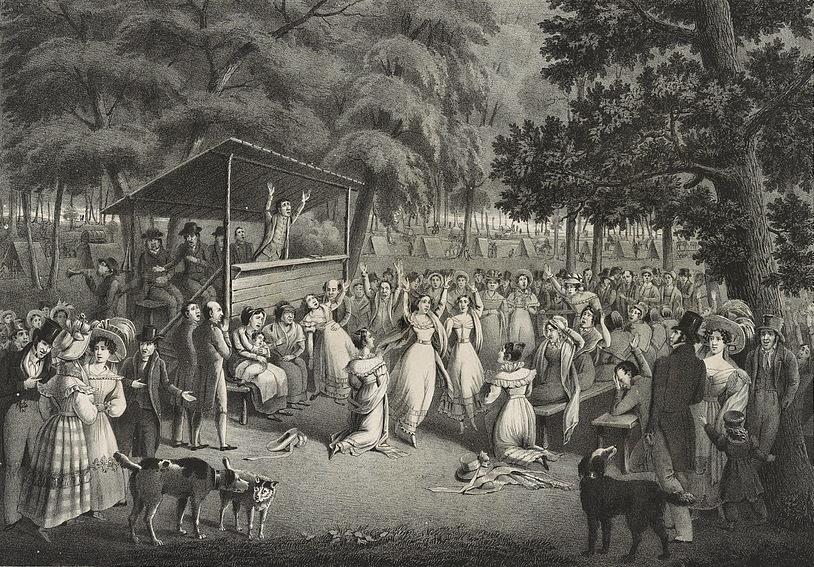 2nd Great Awakening camp meeting
2nd Great Awakening camp meeting
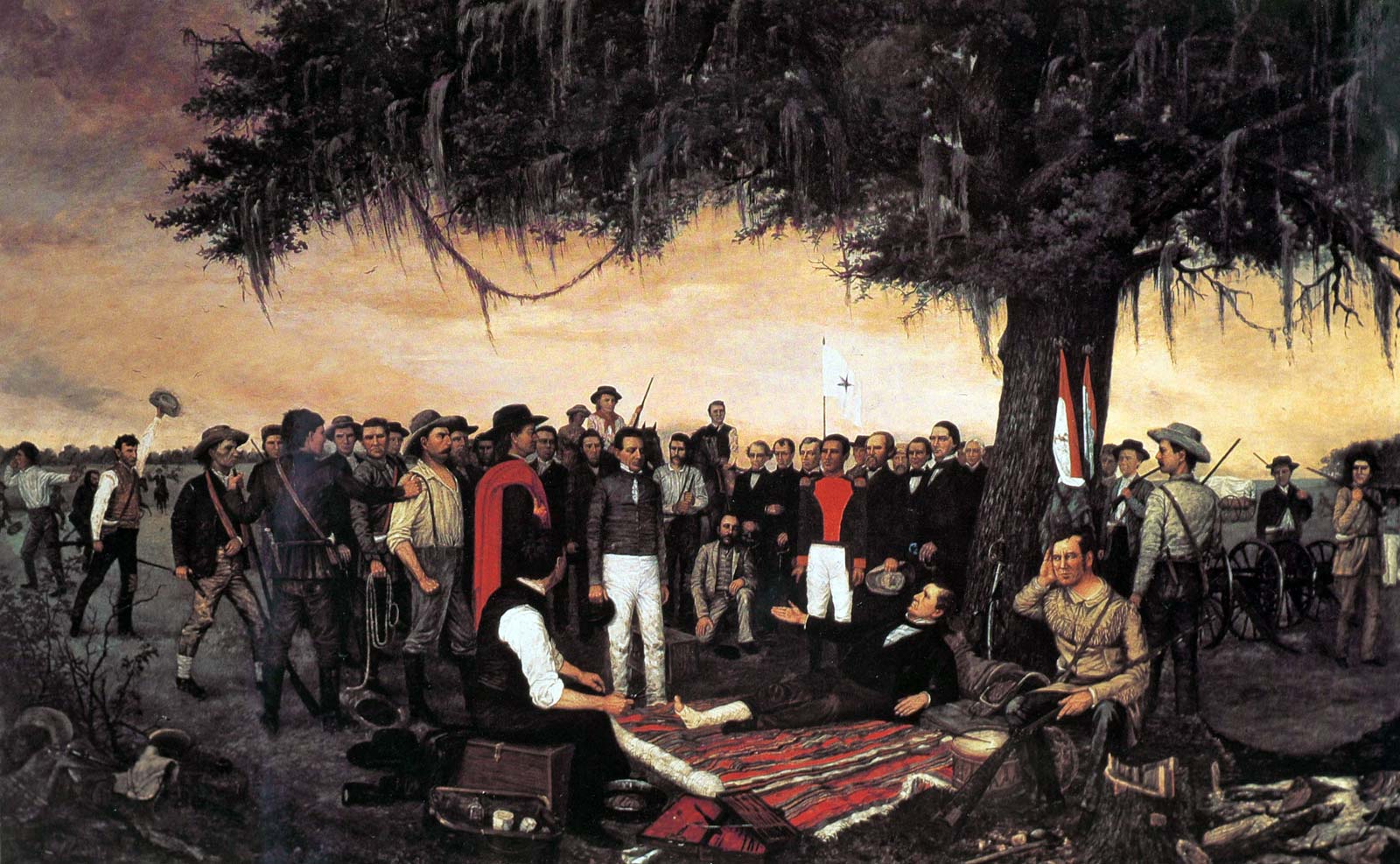 Santa Anna surrenders to the Texans - Battle of San Jacinto - 1836
Santa Anna surrenders to the Texans - Battle of San Jacinto - 1836
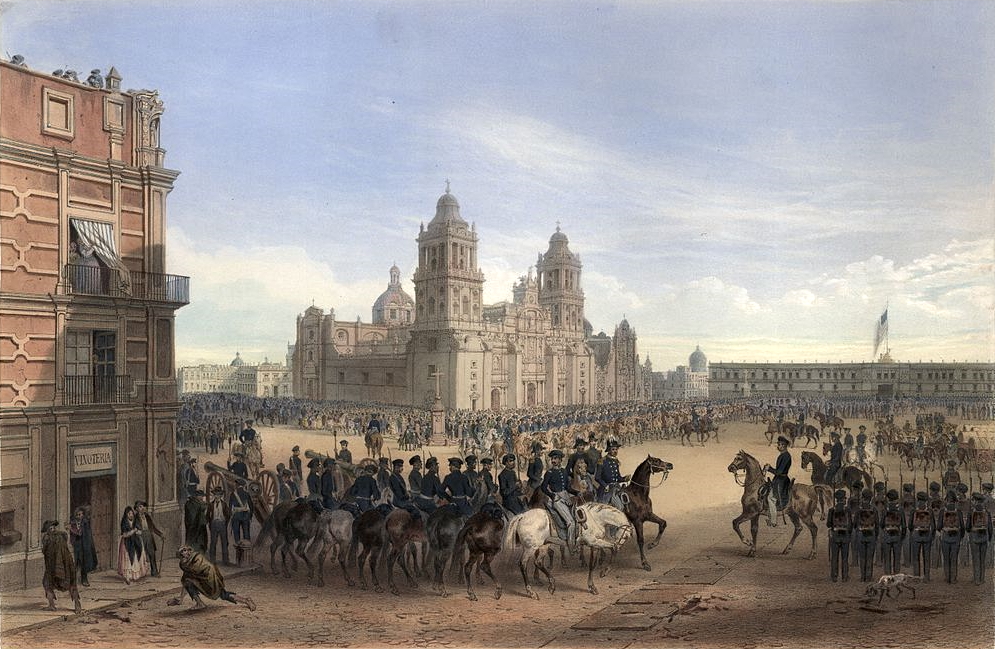 American troops in Mexico City - 1847
American troops in Mexico City - 1847
|
France
Louis-Philippe had cultivated his reputation as "citizen king" ... yet
at the same time he was as absolutist in his heart as any other
European monarch of his day. His prime minister, Guizot,
skillfully kept a working majority in the French parliament in support
of the king's increasingly restrictive policies, which clearly favored
the prosperous industrial upper middle class ... at the expense of the
French working class.
But the French working class – which had been the
backbone of the 1830 Revolution, but which had been denied any
political fruits from its sacrifices – was not unaware of its political
rights ... and importance ... in the French scheme of things.
French intellectuals attracted to the lofty ideas of "socialism" had
been clear about the key role that the working class was destined to
play in the industrial society taking shape in France. Being
hounded by the French police, secret societies began to be formed by
such socialists ... and also by republicans hoping to see France
returned to the status of a republic. All this (plus numerous
attempts at assassination of the king) made Louis-Philippe and Guizot
all the more resistant to any call for political reform.
By mid-late 1847 even members of the middle class
began to gather at special banquets to discuss the need for immediate
reform. Then in February 1848 a massive banquet was scheduled to
take place in Paris ... though Guizot convinced involved members of the
legislature to call off the event. But it was too late – for
things began to move forward anyway: the streets of Paris were
filling with people demanding Guizot's dismissal. The National
Guard was called out to disperse the rowdy crowds ... but refused to go
against the crowds, with some guardsmen even joining them. The
panicked king then dismissed Guizot ... but crowds gathered at Guizot's
home, protected by army regulars. Shots were fired and some 50
individuals were shot ... then carried through the streets on carts
that night. The next day a huge mob gathered at the king's
Tuileries Palace ... causing Louis-Philippe to flee the country in
disguise.
A new Republic was declared by a provisional
government ... and, following the lead of the socialist Louis Blanc,
the new government proposed – as a matter of the "right to work" – the
creation of workshops for the unemployed. At this, thousands of
unemployed workers gathered in Paris for jobs ... greatly exceeding the
government's real ability to set up workshops. Instead, the
government agreed to pay the unemployed a small financial compensation
... which (because of this generosity) by early summer had swelled the
ranks of the unemployed to over a hundred thousand! This not only
threatened the treasury of the new Republic, but left industries unable
to hire workers, who were content to live off the small dole rather
than the earnings of their labor.
The effort to bring some control over the program by
setting tighter qualifications for the dole now produced its own
political problems in the Paris streets. The Republic's military
was called in to disperse angry crowds, the soldiers fired on them (and
they fired back), with over ten thousand people killed or wounded in
the encounter. Martial law was extended over the country ...
while the Republican politicians quickly prepared the new Republican
constitution – which provided for universal adult male suffrage.
Finally in December of 1848 elections were held ...
and Louis Napoleon, nephew of the Emperor, was elected by a huge
majority of the French voters. A new era had begun in French life.
|
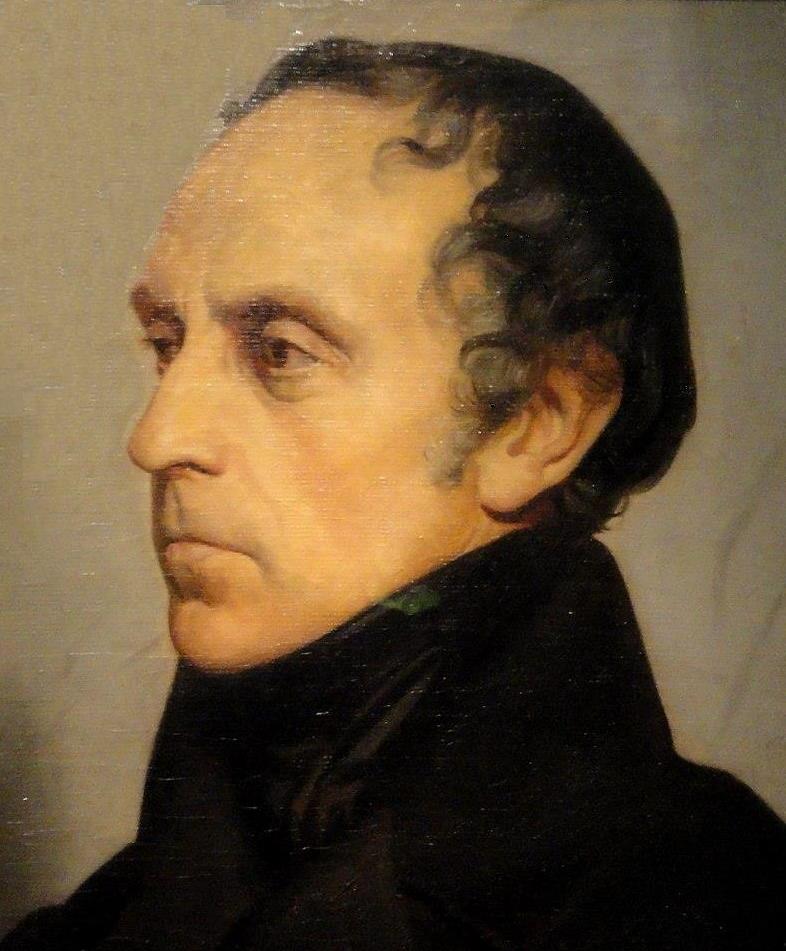
François Guizot
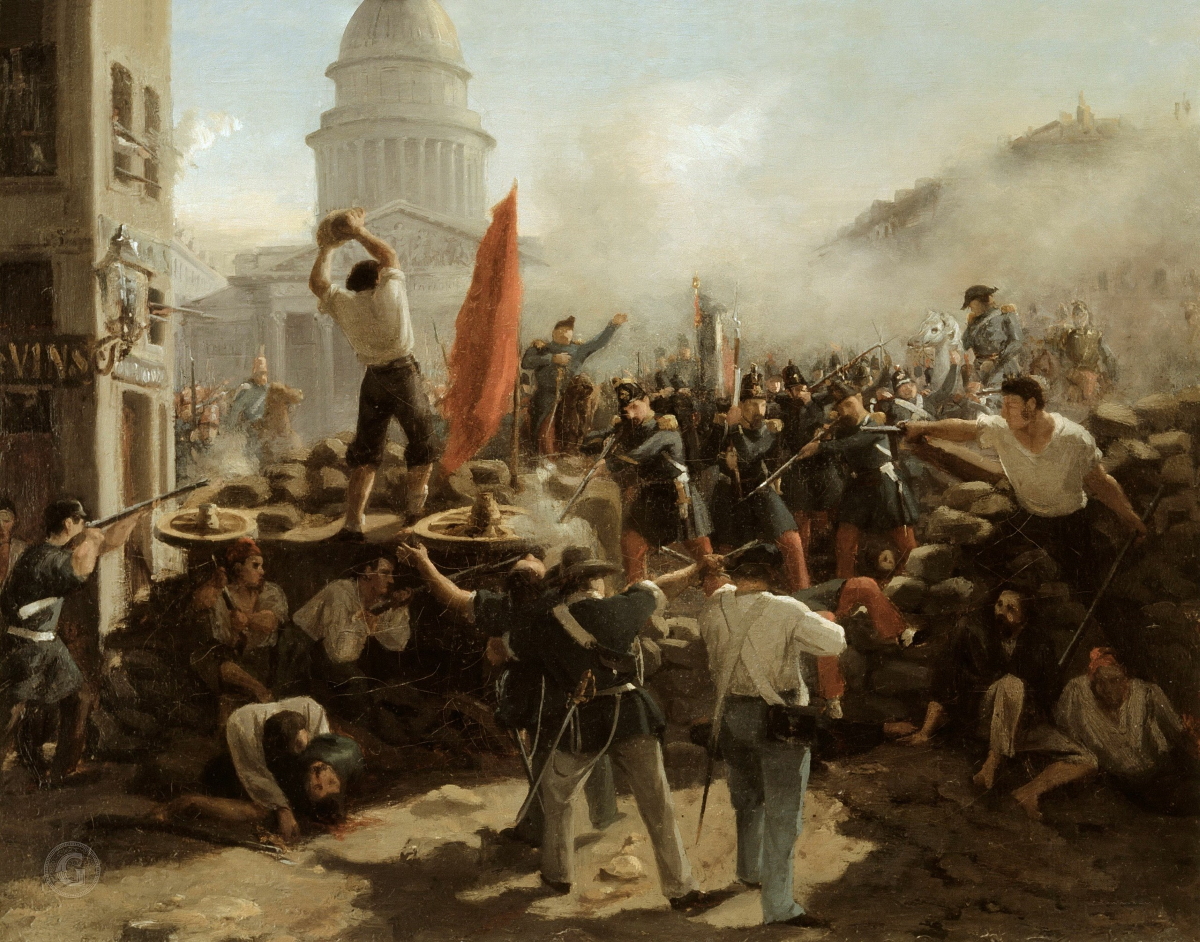
The Barricades at Rue Soufflot - June 25, 1848 - by Horace Vernet
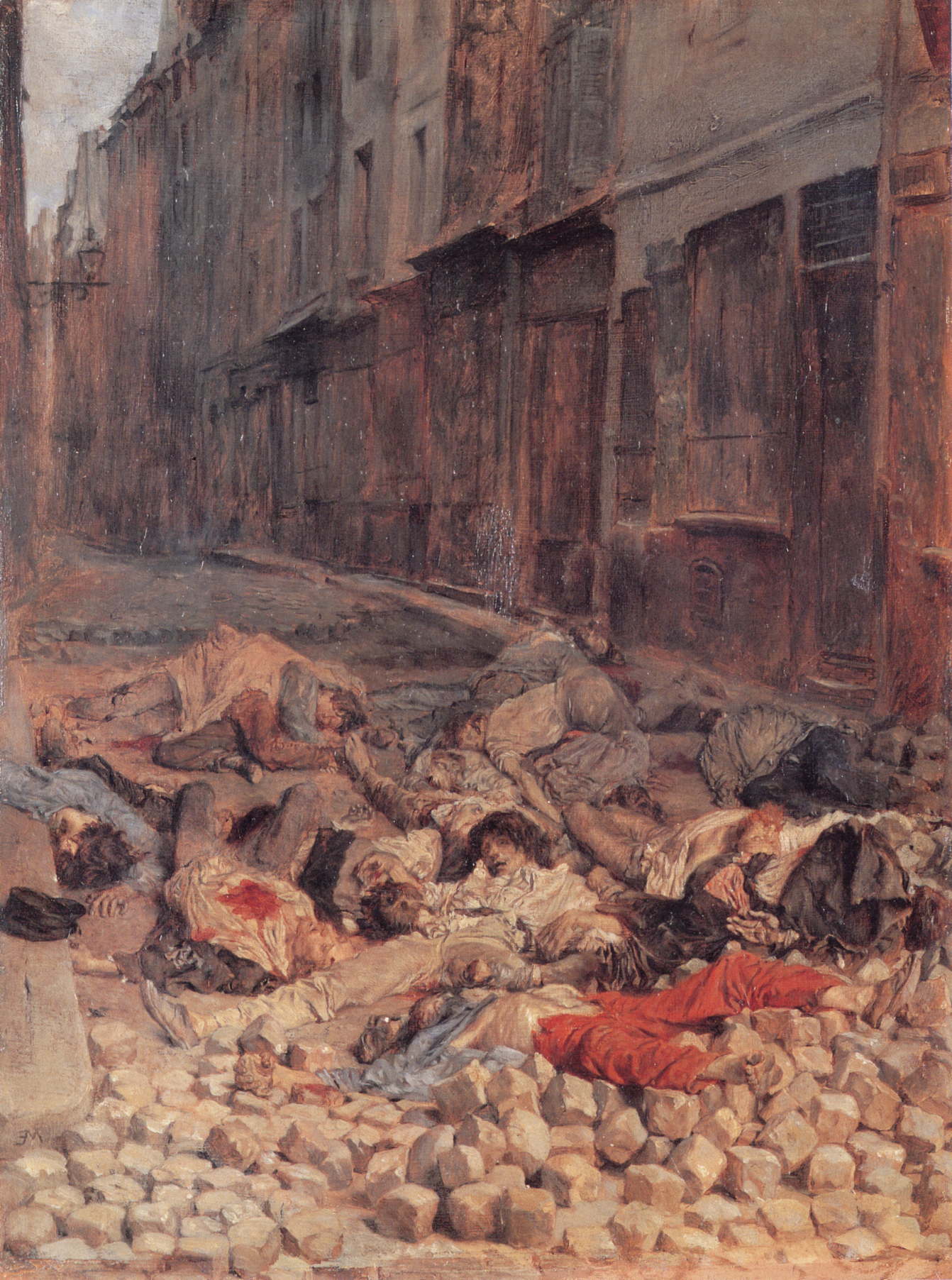
The Dead at the Barricade of the Rue de la Mortellerie - June 1848 - by Jean-Louis-Ernest Meissonier
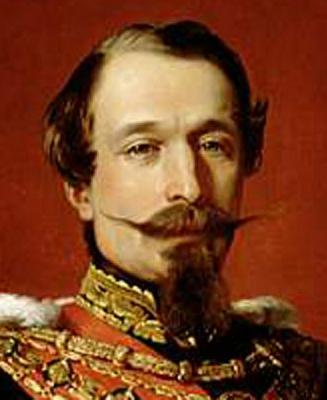
Louis Napoleon - President of the Second French Republic (1848-1852)
|
The failed effort at Rome
In Italy, revolutionary radicals were demanding the creation of a new
Roman Republic - replacing the Papal States. In the chaos, Pope Pius
IX's Minister of Justice Peligrino Rossi was assassinated (November
1848). Also, the Pope’s protective French troops had just been
called back to France to deal with the chaos there ... leaving the
Pope’s own small army unable to hold back a much larger Italian army
intent on taking Rome. At this point Pius escaped to Naples ...
and the revolutionaries announced the formation of their Roman Republic
(also November 1848). The hope was clearly that this Roman
Republic would be the springboard for an even larger Italian Republic.
The Republicans authorized the pope to return to Rome to continue his
religious duties ... even though his political role as Head of the
Papal States was to be ended. But the pope was not interested in
the compromise. Indeed, in retaliation, Pius threatened
excommunication of those Catholics supporting the Republic ... even of
those who simply voted in the Republic’s new elections (there was a 50%
turnout however).
But newly elected French President, Louis Napoleon decided to come to
the aid of the Pope and sent a huge French army (along with some
Spanish troops) into Italy (April 1849). After a month’s siege at
Rome, the Republicans agreed to a truce ... which reestablished the
pope’s political powers - although Pius would not return to Rome until
the French troops agreed to full support of the papacy.
These troops would indeed continue in that role ... until 1870 when
another round of revolutionary events in Europe led to the creation of
the Kingdom of Italy – by many of the same individuals who had directed
the effort to establish the Roman Republic in 1848-1849.
The Austrian Empire
Meanwhile,
events in France had spread quickly eastward to Vienna, inspiring
equally dramatic events there. In March (1848) university
students and craftsmen joined forces to march on the emperor's palace
calling for Metternich's resignation. When members of the court
aristocracy joined in the demand, Metternich realized that he had lost
his political grounding ... and escaped to England. When the
Emperor agreed to institute a number of liberal reforms, the revolt
seemed to have achieved its objectives.
At the same time the French events had also stirred
up a similar spirit of revolt in Prague ... where demands for liberal
reform of the imperial government took on strongly Czech nationalist
tones. Now hard pressed by this spreading spirit of revolt, the
Emperor agreed to the demand to make Czech co-equal with German.
Hungary was next. Protesters gathered in
Budapest demanding a constitution and parliament of their own ... which
the Emperor agreed to institute. But then when other
minorities living within the Hungarian realm (Serbs, Croatians,
Rumanians) asked for similar rights, it was the Hungarians who refused
... causing war to breakout between Hungary the minorities.
In Austrian-controlled northern Italy similar events
unfolded. With the fall of Metternich in March, an Italian mob in
Milan forced the Austrian garrison to evacuate the city. Venice then
joined the revolt, then all of Lombardy and the Tuscany province ...
with Charles Albert, king of Sardinia-Piedmont, sending troops to aid
his fellow Italians. Various Italian states put themselves in the
hands of Charles Albert ... and the Italian coalition met the Austrians
in battle. The results were something of an Italian retreat ... leaving Italian
land in the hands of the Austrians. This in turned infuriated the
Italians ... and ultimately shamed Charles Albert. He then simply
abdicated, leaving his government in the hands of his son Victor
Emmanuel ... who now took a tougher stand against the Austrians.
Now the Austrians found themselves not doing very well in the contest
with the new "Italian" leader, Victor Emmanuel.
The Habsburg empire seemed to be crumbling
everywhere. So distressed was Emperor Ferdinand over all this
that he abdicated in December, elevating his 18-year-old nephew, Franz
Joseph, to the Austrian emperorship.9
9This would be the beginning of the 68-year reign of Franz Joseph, which would last until his death in 1916.
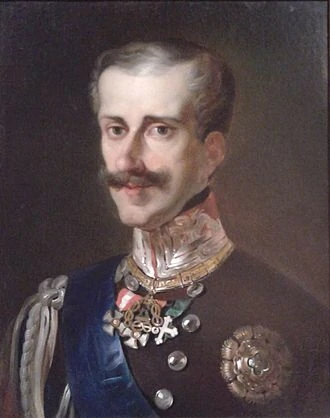 Charles-Albert of
Sardinia
(ruled
1831-1849) 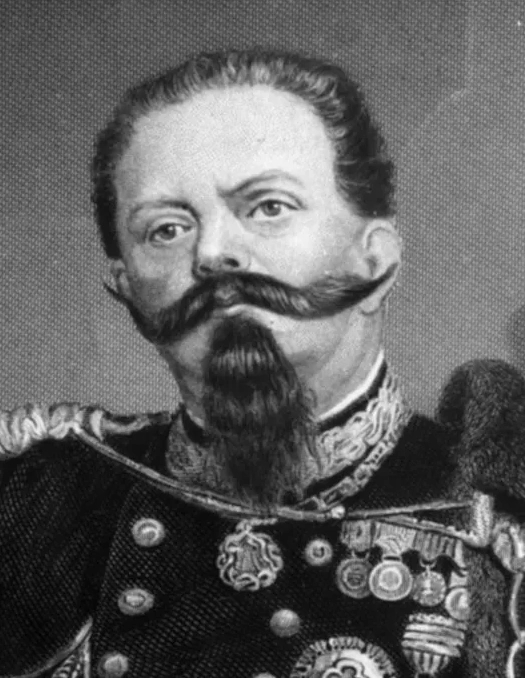
Victor Emmanuel II
(ruled 1849-1878)
|
Prussia
Prussian king Friedrich Wilhelm IV (who had come to
power in 1840) had made it clear that he ruled by the will of God
alone. But with the retreat and fall of royal absolutism all
around Europe, the king found himself facing the same demands in Berlin
for liberal reforms of his government. With seemingly no other
options he yielded ... promising such reforms ... meanwhile waiting for
the tide to turn. Which it soon did.
|
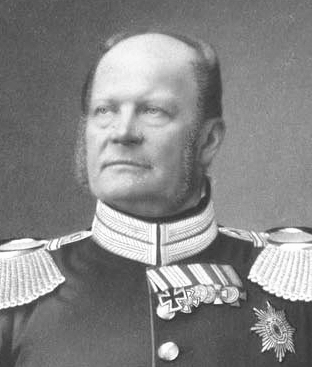
Prussian King Friedrich Wilhelm IV (ruled 1840-1861)
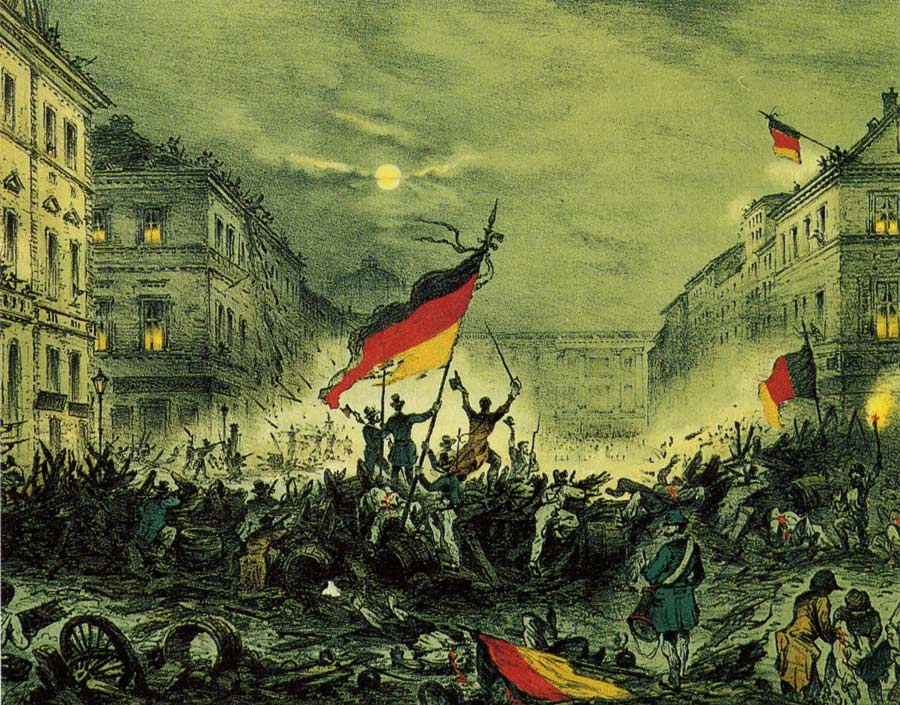
The Berlin uprising - March 1848
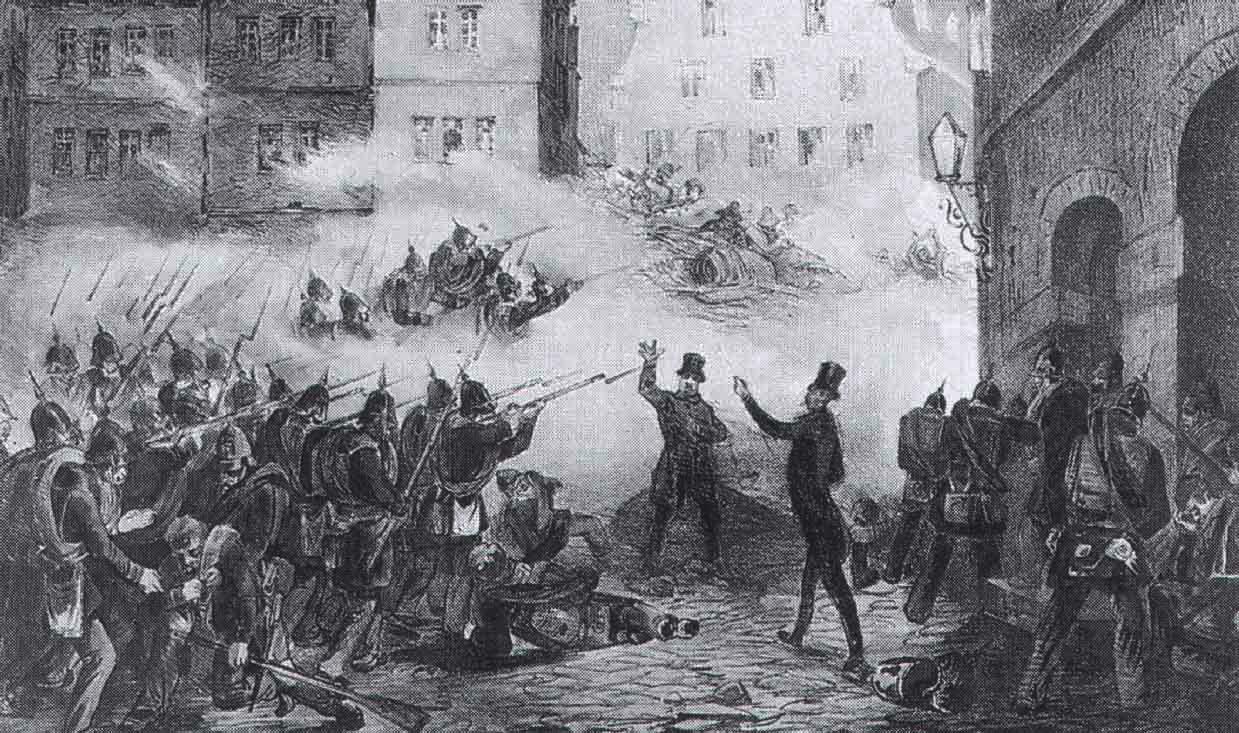
Fighting at the Berlin Barricades
|
The Frankfurt Assembly
A major hope of the Liberals calling for
constitution and written guarantees of citizens" rights focused on the
German Confederation which gave its authority over to a constitutional
assembly voted on by a large German electorate. This Assembly
gathered at Frankfurt to begin the writing of a new constitution for a
united Germany. Although it was somewhat slow going, the serious
hitch in the program did not appear until the Assembly was ready to
finalize its works in early 1849. Only one question remained: who
would reign over Germany as a constitutional monarch: a Hohenzollern
(Prussia) or a Habsburg (Austria)? The Habsburgs were not willing
to separate their non-German territories from a new Germanic empire ...
and thus they would not take the position at the head of the new German
state. By the time in April when the Assembly turned to Prussian
king William IV to take over the new constitutional Germany, William
had recovered much of his lost political strength and made it very
clear that he would not head any kind of a state that gave authority to
its ruler through the popular will. He would answer to God and
God alone.
|
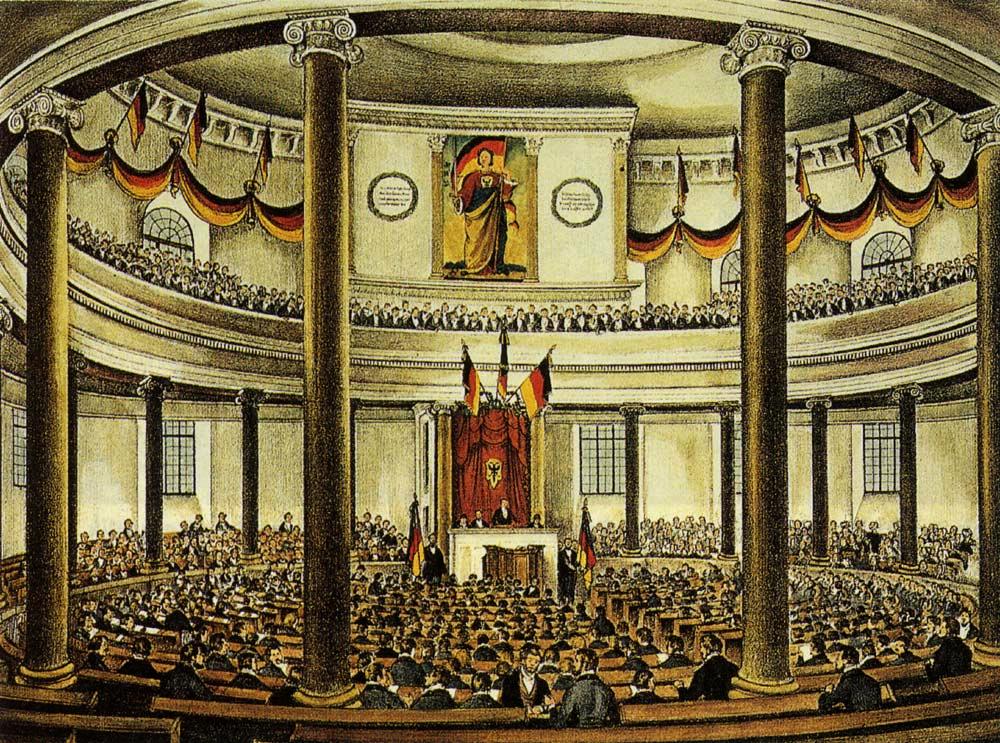
The Assembly at Frankfurt - 1848
|
The Reaction
Now without any prospect of a king to lead their
new state, the whole constitutional project began to fall apart.
Although many German states had signed onto the project, four major
German states (in addition to Prussia) announced that they would not
accept this arrangement. With that the Frankfurt Assembly
dissolved.
But that was not the end of the matter.
William not only shut down the Prussian Parliament, but after having
subdued protests in his own land, sent Prussian troops to crush the
rebellions in some of the other German states. Thousands of
liberal reformers were forced to flee Germany; those who failed to do
so were imprisoned.
And much the same event occurred in Habsburg
Austria. Austrian troops even bombarded their own capital into
submission, and then turned on the Hungarian reformers. When the
Hungarians fought back fiercely Tsar Nicholas sent Russian troops to
help the Austrians to crush the new Hungarian Republic and force
Hungary back into the Habsburg Empire as an Austrian province.
Likewise the Austrians were able to retake
(brutally) the territory they had just lost in Italy ... leading the
aged king of Piedmont, Charles Albert to turn his throne over to his
son, Victor Emmanuel, hoping that this would soften peace terms with
Austria.
Nonetheless, despite this huge victory of
monarchical absolutism, Victor Emmanuel kept his father's liberal
constitution of Piedmont in place ... thus preserving for him the
leading position in the hearts and minds of Italian liberals, who
continued to dream of an independent Italy.
|

Go on to the next section: The Urge to Rationalize and Control Social Dynamics
 Miles
H. Hodges Miles
H. Hodges
| | | | | | | | |


 An overview
An overview
 The restoration of the monarchies
The restoration of the monarchies
 The growing spirit of rebellion
The growing spirit of rebellion














































